Intentional Destruction of the Non-Governmental Nicholas Roerich Museum
Presentations at a Press Conference of the International Center of the Roerichs “Intentional Destruction of the Non-Governmental Nicholas Roerich Museum:
Results and Consequences”, 01.30.2018
 Alexander Stetsenko, the Vice-President of the International Center of the Roerichs Alexander Stetsenko, the Vice-President of the International Center of the Roerichs
First of all I’d like to thank everyone who came to our press conference. Today’s press conference is held on a memorable day for us, first, 25 years ago, Svetoslav Roerich, the founder of our Museum, passed away. Svetoslav Roerich donated the legacy of his parents, Nicholas and Helena Roerich to Russia for free in the 1990s for creation of the Non-Governmental Nicholas Roerich Museum. And the second incentive for us to hold this press conference was that 9 months have passed since the State Museum of Oriental Art with the support of the Ministry of Culture and Special Forces seized the Lopoukhins’ Estate and all the property of the International Center of the Roerichs. It was on April 28 – 29, 2017. Only recently, actually, on January 15, 2018, we managed to visit the estate, despite all our demands, and then at the enforcement proceedings. We saw firsthand what power of destruction our Non-Governmental Nicholas Roerich Museum and all our property were subjected to. This, of course, is a source of our great indignation. We have decided to bring to the attention of the general public the outrages that are committed in this Estate.
The most important point of this situation is in the illegality of the entire seizure. On April 28 – 29, 2017, the court decisions on the International Center of the Roerichs’ eviction did not come into force, they would come into legal force only 5 months later. But the capture was committed. The property of the International Center of the Roerichs was abusively taken over without any court decision, it is not available until now. But we were deprived of our property, and we do not have the opportunity to use it for 9 months. It should be noted that on April 29, 2017, the Chief Investigation Department of the Ministry of Internal Affairs of Russia, under the guise of investigative actions in the case of Master Bank, transferred the buildings to the State Museum of Oriental Art for operational management, and the property located in them for safe custody. Thus, I do have a question: either the leaders of the State Museum of Oriental Art were the non-staff personnel of the Ministry of Internal Affairs in the matter of this property seizure, or the Ministry of Internal Affairs simply covered the illegal actions of the officials from the Ministry of Culture.
But before coming to the concrete evidence of all these outrages, I would like to recall briefly the background of this matter. It is well-known that Svetoslav Roerich donated the heritage of his family to Russia for the creation of a non-governmental museum in the 90-es of the XX century. At that, Svetoslav Roerich set two mandatory conditions. The first one was that the museum was to be of a non-governmental format. The second one was that the Museum was to be located in Moscow. The fulfillment of the first condition Svetoslav Roerich described in his famous article “Inaction is not an Option!”. This article is now before you, it was published in July 1989 in the newspaper “Sovetskaya kultura”, where the owner of the heritage emphasized that our Center-Museum, which was promised to him to be created should be in the format of an exclusively social organization, outside the subordination of the Ministry of Culture, “and, especially, of the State Museum of Oriental Art”. This was the first condition. On this occasion, the Resolution of the Council of Ministers was adopted to create a non-governmental Center-Museum as the main base of the Soviet Fund of the Roerichs. This Decree gave instructions to the Moscow City Council to provide the premises to the Museum. Literally a few days later, the Moscow City Executive Committee issued a decree to put the Lopoukhins’ Estate at the disposal of the non-governmental Museum.
This Order clearly stated that the Government assumed the responsibility to reconstruct the main building of the estate where the Museum was to be located. A short time later the Government approved the plan for recreating and adapting the Lopoukhins’ Etate to the needs of the non-governmental Center-Museum.
It must be said that from the 90es until the time of the capture, the International Center of the Roerichs faithfully fulfilled its obligations to recreate the estate. And not only to recreate the estate. Two points should be noted. First: the Center fulfilled all the obligations given to Svetoslav Roerich. A non-governmental museum was established in the Lopoukhins’ Estate. It opened its exposition on February 12, 1993, and a year earlier, as soon as the heritage came from India, mobile exhibitions began. Will you show the halls, please, we will not dwell on this issue. Such a Museum was created by the staff of the International Center of the Roerichs (the ICR) under the leadership of Lyudmila Shaposhnikova, with the strongest support of the public.
The ICR has fulfilled its obligations to the State to recreate the Lopoukhins’ Estate. Now you see the building that we had received, this was a dilapidated building, and this is the building that was re-established and brought to its original appearance by our Center with the support of patrons and that of the general public. The International Center of the Roerichs was recognized for this not only in Russia, but also abroad. The ICR was awarded the National Prize in the nomination “Restoration”. It was awarded the European Union Prize for the preservation of cultural heritage of Europe, as well as with the Memorable Sign and the Diploma “Europe Nostra”. The Center was also awarded with the honors of the Russian state. Suffice it to say that the President of the Russian Federation decorated the Director General of the Museum with significant government awards. The first one was the Order of Friendship “for the preservation of the Roerich heritage and the development of Museum studies” in 2006. In 2011 Director General of the Museum was decorated with the “Order of Merit for the Fatherland”, IV degree. It should be noted that these awards were presented personally by Ministers of Culture. The Minister of Culture A. Sokolov was the first to award, the Minister of Culture A. Avdeev the second. I would like to cite the words of Minister A.Avdeev, who said, presenting the award to Lyudmila Shaposhnikova, “Thank you for the fact that for many years you have been debunking all kinds of fables about the life and work of this extraordinary family, collect and fight for their Heritage, explain the philosophical system of the Roerichs. For the fact that in our difficult times you have the courage to fight for culture”. This is what he said in 2011.
It should be noted that the Center’s achievements to preserve the Roerich Heritage are, of course, colossal. Here are some figures.
1. About 400 paintings of the Roerichs were returned to Russia and donated to the Non-Governmental Nicholas Roerich Museum with the help of patrons.
2. The Non-Governmental Nicholas Roerich Museum held more than 600 exhibitions in Russia and other countries for 25 years.
3. More than 250 titles of printed materials with a total circulation of more than 500 thousand copies of books from the Roerichs’ heritage and about the Roerichs were published.
4. The quarterly magazine “Kultura I Vremya” (“Culture and Time”) was published.
5. Science-education films were produced.
6. An intensive scientific work was currently under way, the Academic Council operates in the ICR, as well as annual conferences, seminars, lectures and other events.
I work up the courage to say with certainty and responsibility that none of the state museums in which the Roerichs’ heritage is kept ever even come close to the achievements that the International Center of the Roerichs have before the Roerichs and Russia.
Then the question arises, what happened with the arrival of the new Minister of Culture in 2012 when a campaign to deliberate destruction of the Non-Governmental Nicholas Roerich Museum, the liquidation of the International Center of the Roerichs and the seizure of the Heritage was launched I understand, the time is very short, so I will give you some of the steps for you.
The main seizure began in 2015 after the death of Lyudmila Shaposhnikova in August. And a little earlier, Yevgeny Primakov, our long-time friend, a trustee and a member of the Board of the International Center of the Roerichs, passed away. These two persons were a very serious deterrent to the destruction of the Museum.
Further. After this, a campaign was initiated to discredit and eliminate the ICR, seize the estate, destroy the Non-Governmental Nicholas Roerich Museum. I will give some facts. Show the letter of the Minister of Culture to the Mayor of Moscow, please. Vladimir Medinsky wrote in this letter in September 2015, if I am not mistaken, that he was going to fulfill the will of Svetoslav Roerich and for this purpose asked to transfer the Lopoukhins’ estate to the federal property. This was not true, because Svetoslav Roerich’s will had been fulfilled by the ICR, as it was shown just now in the letter.
In February 2016, the Ministry of Culture held the Ministry’s Collegium at which it was decided to create a State museum at the funds and premises of the Non-Governmental Nicholas Roerich Museum as a branch of the State Museum of Oriental Art. Moscow authorities transferred the estate to federal property. The Federal Property Agency of the City of Moscow promptly transferred it to the State Museum of Oriental Art to the operational management. It immediately began the procedure of terminating the Lopoukhins’ estate free use agreements. In 2016 the claims on eviction were brought to the Arbitration Court. Considering that the claims were not supported by any evidence that we violated the obligations before the Government to maintain and use the estate, the Ministry of Culture launched unscheduled inspections by the Moscow Department of Cultural Heritage and the Federal Property Agency of the City of Moscow. This was despite the fact that just a few months earlier the Moscow Department of Cultural Heritage conducted a routine check and no comments were made.
In the course of the inspection, startling facts began to “come to light”, about 17 commercial organizations turned out to be registered on the territory of the estate, this was compromising fact, and the cause for termination of the contract. We really knew nothing about it. There were facts of an allegedly unsatisfactory state of the estate. At the same time, no data, no testimony of the International Center of the Roerichs, no documentation was taken into account by the court. Even the Expert’s opinion of the leading specialist in restoration, honorary restorer, that the Moscow estate is one of the best in Russia was not taken into account. The court refused the ICR to conduct a forensic examination. We were deprived of the right to defense at all! And the decision on the termination of contracts and eviction was made. This was in March 2017.
What happened? The decision did not come into legal force, because the International Center of the Roerichs appealed against it, but the Lopoukhins’ estate was seized as well as the whole property by the Museum of Oriental Art. It was a very notable moment, I think that you knew about it, but I have to remind it in brief. On April 28, 2017, at night, about 9 p.m., the director of the State Museum of Oriental Art together with its staff, with the support of unmarked special units, changed the security of the ICR, broke into the territory and tried to take possession of all the buildings. Considering that at that time there was a large number of the ICR staff in the territory because of the concert of the Bulgarian pianist, they failed to capture the estate. The Ministry of Internal Affairs, unfortunately, which was called by the International Center of the Roerichs, was passive about this incident. We had to make some compromises, but the International Center of the Roerichs managed to remain its guard on the territory of the Estate. So by the morning of April 29, 2017, the guards of the State Museum of Oriental Art, and that of the International Center of the Roerichs remained in the territory, all premises, and entrances of the buildings were sealed. That is, the State Museum of Oriental Art failed to fulfill the task of seizure. Therefore, on April 29, 2017, in the afternoon, the Main Investigation Department of the Ministry of Internal Affairs of Russia arrived, and by its decision transferred the buildings and property to the State Museum of Oriental Art to secure custody. Indeed, the question arose, on what basis? These issues were being disputed, and our lawyers will speak on this subject, but this is a long and serious process, considering the state of our judicial system. I will not dwell on this.
We were not allowed into the estate for nine months. Our employees are on duty near the Museum all nine months until today. They can not be removed from there. And I have no moral right to send them home. Why? Because their home, their property, their personal belongings are there. Considering all the data, photos and video filming throughout all this time, the property of the International Center of the Roerichs was taken from the territory of the estate. We have all the evidence of this. We were not allowed there. We managed to enter the territory of the estate, when the enforcement proceedings began to implement the court’s decisions to release the ICR property, that is, to export it from the Lopoukhins’ estate. Can you imagine? It was on January 15! And when our staff went inside with the bailiff, who was still quite independent at the time, and he demanded despite the objections of the State Museum of Oriental Art to open the premises, we saw that devastation for the first time... I would call it a vandalism committed by the staff of the institution of culture, that of the State Museum of Oriental Art. The doors were broken, the safes were ransacked, and the locks were directly cracked. The things were piled up in several rooms, mixed up, the furniture broken, disassembled, scattered. If a stranger disassembles someone’s furniture, it is beyond repair. This was done not by us, as owners, obliged to remove the property but by someone else’s organization.
I will not dwell on this for long. My colleagues from the Museum will tell you about this in detail and present the facts to you. But I would like just to say about some points on personal property. Well, you can ask what personal property has to do with the investigative actions in connection with Master Bank. Since May our employees wrote about this. After all, this happened suddenly, at night, the ICR staff left the Museum in the evening but in the morning they were not allowed inside. Many of them worked for more than twenty years. Of course, this was a non-governmental organization, the workers brought their personal printers, personal belongings there. They immediately began sending letters to the State Museum of Oriental Art requesting to return all these. But the State Museum of Oriental Art got rid of us by unsubscribing. Only when the patience of the staff was over, they began to appeal to the courts in order to disgorge the property through the court. However, we were not returned everything. Many things appeared to be missing, such as valuable icons in a silver setting, expensive gift books, sculptural compositions. The employees up to now cannot get their passports, certificates of marriage and birth which were in the work desks and safes. As for me, I managed to receive my personal foreign-travel passport only after filing a court complaint in January 2018. I want to ask the leadership of the Ministry of Culture on what grounds it was committed. Our money was gone. I had a fireproof safe in my office in the Museum, there were passports and other documents. When we entered my office on January 15, we found the safe cracked. Why?! We are mainly indignant, but we must still restrain ourselves.
I will continue my speech. Court proceedings on our eviction began. Yesterday we met with bailiffs and representatives of the State Museum of Oriental Art. Do you know why? They hurry us, they say, “Hurry up.” For God’s sakes, we are ready to export our property, but by a court decision, they should allow us to enter the premises to take out the property. Considering what happened, let us face it, they owned the property for 9 months, didn’t they? They did. And now we are exporting it. You give the property to us, we draw up the acts, you sign, we export it. But no, they refuse to sign the acts. Then I, as the head of the organization, said, “I refuse to export this property. How so? This is not the classic situation when the owner, receiving a court decision on eviction, collects his property and exports it, leaving with it. We were expelled, somebody puts together our things for us, and now we are forced to leave without signing the documents. It will not happen.
This is about the property and the Estate. But the most important question, is, of course, the seizure of the Heritage. I will remind you only certain dates. My time is running out, I’ll try to do it quickly. The year 2015. The Ministry of Culture demanded the prosecutor’s office to remove the Heritage from the International Center of the Roerichs, from an “alien, illegal possession”, arguing that the ICR illegally owned the Heritage. The prosecutor’s office checked the International Center of the Roerichs five times, and failed to draw this conclusion. But if the Ministry of Culture believes that the ICR illegally owns the Heritage, there is a completely civilized way to file a suit in court, prove your rights there, and take it. But no. The Ministry of Culture did not bring proceedings in court. What for? Because the Ministry does not have any rights on property. That’s why, the Museum was captured on April 29, 2017. Further, soon after the seizure, Minister of Culture said from the rostrum of the State Duma, I’m quoting RIA Novosti (News Agency’s) message of May 17, 2017, “Believe me, Roerich’s paintings and his creative heritage will not only suffer, but finally returns to the fold of the Russian state, to which, actually, the Roerichs bequeathed it. “ I have quoted Minister of Culture. And now I’d like to provide evidence that the minister was lying.
Here it is, the first one, I show you the letter of Svetoslav Roerich to the President of the Russian Federation of April 26, 1992, where he clearly requested support in returning from the Ministry of Culture that part of the Heritage that was illegally retained. Svetoslav Roerich insisted on transferring it to the International Center of the Roerichs.
Here is the second document, that is the letter of Svetoslav Roerich to Moscow Mayor Yuri Luzhkov of the same year of 1992, where he clearly claimed, “... In 1990, I handed over the legacy of my parents to the International Center of the Roerichs (former Soviet Foundation of the Roerichs), I’m the honorary President of it. <...> ... I would like to ask you personally to assist in transferring the Lopoukhins’ estate <...> to the balance or to the long-term lease with the right of sublease to the International Center of the Roerichs.” I quoted the owner of the Heritage.
Further. Here is a letter of Svetoslav Roerich to the Roerich organizations of Russia and other independent states.
One can cite other documents, where Svetoslav Roerich clearly expressed his idea to hand over the Heritage to the International Center of the Roerichs.
But what does the Ministry of Culture do after the seizure? You understand, I can definitely say with full responsibility that the Ministry of Culture, in the person of the minister and especially his first deputy, Mr. Aristarkhov, was taking all measures to liquidate the organization. The first attempt was made in 2016, when, at the request of Aristarkhov, the Ministry of Justice checked the ICR for extremism. They wanted to present us as an extremist organization. The organization that conducted such a successful cultural activity.
The second proof is the withdrawal of the rental certificate for the film “The Call of Cosmic Evolution” because of demonstrating a symbol of swastika. We showed fragments of the chronicle for several seconds within the framework of the victory of the Soviet people in the Great Patriotic War against the background of the prophetic paintings of Nicholas Roerich. Two points. And why, in fact, were they going to recognize us as extremists? Yes, because if an organization is recognized as an extremist one, then all its property is confiscated, without any proof in it. But it did not work.
Further. Now the Ministry of Culture, and I have full proof of this, now I will prove to you, trying to liquidate the organization because we allegedly failed to fulfill the requirements of the registration authority. What were the requirements? Let’s take, for example, the charter of the International Center of the Roerichs. Here is one example, in May 2017, the Ministry of Justice approved the charter of the International Center of the Roerichs with amendments. What happened after two months or less? We received a warning from the Ministry of Justice with a demand to make changes again. This was a requirement of Mr. Aristarkhov. At this time, the Khamovniki Prosecutor’s Office, based on numerous letters from Aristarkhov, was trying to protest the charter of the International Center of the Roerichs, even in court. On this occasion in late August, an administrative claim was filed by the Khamovniki Prosecutor’s Office to force the International Center of the Roerichs to amend the charter. You know, even the judge lost his temper and said, “What on God’s earth? First, you approved the statute, a few months later, the Ministry of Justice was trying to protest it, and at the same time, the Prosecutor’s Office on other grounds, was also trying to protest this Charter.” I will not dwell on this for long, I will say that the judge closed this administrative case. We did fulfill the demand of the Ministry of Justice, on October 8, 2017, we held an extraordinary conference and reconsidered the Charter once more. It would seem that we at last fulfilled the demands of the Ministry of Justice. Imagine our surprise when in November we got a notification that the Ministry of Justice did not accept our amendments and put forward very different requirements than those specified in the first version of warning. At that time, the Prosecutor’s Office was considering new letters of Mr. Aristarkhov, in which the Ministry of Culture stated that it did not like our name and whatnot. The question arose, what the Ministry of Culture had to do with the charter of a non-governmental organization that was not subordinate to it.
We revised our Charter once more. We were doing it for all the New Year’s holidays. On January 8, 2018, our another extraordinary conference was held. We tried to input all these amendments. They transferred it to the Ministry of Justice and did not receive a decision. But if the Ministry of Justice refuses this time, it will be qualified as a repeated non-fulfillment of the requirements of the Ministry of Justice. And what? We will be liquidated for non-compliance with the requirements of the Ministry of Justice, won’t we?
I will conclude my statement, I just want to say, that we are facing an unprecedented case when a cultural organization, the Non-Governmental Nicholas Roerich Museum, created by our great compatriot, is destroyed by the hands of the Ministry of Culture. There are no grounds for this. None of them! Even if we are wrong sometimes, somewhere we allow some omissions for we are not angels. All this could be solved in a quiet normal mode. We found common ground with all ministers of culture. We had contradictions, but they were solved in favor of Russia. We can give a lot of examples. But not with this team, which has taken the course to eliminate and destroy our Museum.
The museum has already been destroyed. You understand, the Museum has already been destroyed! They were not stopped by the prophetic words of Svetoslav Roerich that “the destruction of the Museum is the destruction of the country”. Now there is a question, will there be the ICR or will there not? Of course, their actions are understandable, if they remove the only witness and eliminate this obstacle, there will be no victim, so there no duty-bearer. That’s what is happening in Russia now, and I raise the question, is there a legal system in Russia that can protect such a non-governmental organization as ours? I think no. And our history is a clear example of this. Thank you for your time.
The Moderator of Press Conference
I give the floor to Ilya Shablinsky, a member of the Council under the President of the Russian Federation for the Development of Civil Society and Human Rights. Ilya Georgievich, you have the floor.
Ilya Shablinsky, a member of the Council under the President of the Russian Federation for the Development of Civil Society and Human Rights, Doctor of Law, Professor
Thank you. Dear colleagues, I and some of my colleagues, members of the Human Rights Council, those of Ivan Zasursky, Lyudmila Alekseeva, were seriously touched by this story. A few words how the Council got involved in this grave problem. Early last year, Lyudmila Alekseeva gathered Ivan Zasursky, Mikhail Fedotov, Chairman of the Council and me at her place and asked to figure this out. For about half a year, we went through a large number of documents, visited the Museum, talked with a dozen of different people,visited law enforcement agencies, talked with people from the Presidential Administration. In the end, certain conclusions were formed. I can say that I love the paintings of Nicholas Roerich, I was several times in this Museum in those 25 years, before these problems. I also like the paintings of Rockwell Kent. It seems to me that this is the part of our national culture which influenced the world culture both philosophically and in terms of influence of painting traditions. This is the case.
Here are some conclusions. Indeed, Svetoslav Roerich asked the state to transfer the heritage to a non-governmental organization. This was the principled position. In addition, this was the position of his father, Nicholas Roerich, who had very complicated relations with the then, an atheistic state, and he knew how much aggressive it could be. We know from his articles that any state can behave aggressively as well as a non-theistic one. This was the principled position, the state accepted it, and, in general, was treating it with respect for about fifteen years. And various Russian Governments expressed in one way or another the reverence for the non-governmental organization which created the Museum, they cooperated, in general, it was a very constructive cooperation. Alexander Stetsenko was talking about it, we came to know many interesting facts, there were state awards, recognition. This was the largest non-governmental museum in Russia. The largest one! We have several non-governmental museums but they are too small. We tried to compare - we have a museum of a mouse, a museum of vodka ... In general, it was the largest non-governmental museum located in beautiful large buildings in the center of Moscow. These buildings were transferred to it, however, in a dilapidated state.
During these 15 years of peaceful coexistence and cooperation with the state, the buildings were restored with the assistance of patrons. There were many benefactors and admirers with the Center of the Roerichs. And that’s fine, because the Teaching of the Roerichs is the part of the world heritage, the world one, not only that of Russian! The building was restored and appeared in a wonderful view. We guessed that this, of course, became a temptation. I mean to say that it gave rise to temptation.
At some point, you have to realize that the state has changed. The group of people who makes decisions has changed. People with another consciousness came to power. This happened gradually, as we can judge, but this happened. Yes, for the state, which assumes that it can do everything it wants, that it has the space of arbitrariness, the informal factor matters. We wonder why there were no such impacts, such raider attacks in 2014, 2015.
In 2014 we found the Resolution of the Government of Moscow, by which the historic complex “The Lopoukhins’ Estate” was transferred rent-free to the Roerich Center for a ten-year term. This document was signed by Sobyanin. There were kind relations of the Center with the authorities. We wonder what changed since the same minister of culture was in power? The answer is that at that time the Center had very influential trustees and leaders, Ye.Primakov, L.Shaposhnikova were alive, they solved the whole matter. They passed away in 2015, and we see from documents that the process began literally instantly. The building was already being approached seriously, that must be said straight out, we see that it is the building that matters. Our impression is that during 2015-2016 they were doing all possible efforts to get rid of a completely unnecessary legal entity in order to get everything.
In 2017, a good occasion came in handy. A criminal case against the head of the Master Bank was opened. This occasion was 100% used. Although there were still no legal grounds. Where was the Master Bank with its leader and where was the non-governmental museum to which the Master Bank’s leader helped to restore the building 10 years before? There were no grounds. But the property was arrested, a convenient excuse. Next we tried to intervene, but what could the Human Rights Council under the President do? We wrote a report to Sergei Kiriyenko, the First Deputy Head of Administration, where we pointed out that the Museum was treated badly, that all previous administrations appreciated the contribution of this non-governmental organization to cultural development. But what was happening? We received no answer from Sergei Kiriyenko. But that was actually all we could do.
Alexander Stetsenko called when all the “operations” took place with the building to Ivan [Zasursky], to me, but we felt powerless. We received many complaints over these years related to the seizure and illegal withdrawal of property from different people, yes, and such cases took place. In addition, we understand that property, large property, is almost unprotected here, to be honest. Everything is decided by power administrative resources. We have a cult of power, if someone influential likes your property object, there will be no problem for him. Courts used to approve decisions of executive bodies. Yes, we are facing this, although we have never faced the fact that a non-governmental organization was deprived of its property in this way. We have not heard of such a thing, but we actually doubted it when we wrote a letter to the first deputy head of the Presidential Administration Kiriyenko. We hoped that he would call Medinsky and say, “Well, what are you really? Because of what is all that noise? People go to the Museum. Why do you really want to transfer all this to the State Museum of Oriental Art? Why are you dead set on it? Why, what’s the matter?” But no, he probably did not call to the minister, and there are other relationships there. Maybe our Minister of Culture is more influential, I admit it. But, in fact, the same power solves everything, that is just physical, administrative force. It solves all! We tried to state our position through the media as we could: Ivan in his own way, I in my own way. We eventually had to admit that we, of course, have incomparably fewer resources than our opponents in the Ministry of Culture, which now determines our cultural development. Probably, it will still determine it for several years.
What is left for us? You know, we can only give a moral and legal opinion, it must be given. It will remain. The history will ever give its moral sense.
The attorney at the ICR Dmitry Kravchenko
Good afternoon, dear friends! Well, of course, first of all I ‘d like to say that, and I think, my colleagues will support me, in our lawyer practice this situation is absolutely unprecedented, unique and exceptional. Because we have never faced such an extraordinary ruin of a non-governmental museum by the state in our practice. Well, imagine, it was the largest museum. It’s not just some kind of Vodka museum, there were many halls, tens of thousands of exhibits, it was a great museum. Those who have visited it can confirm that this is a significant heritage. There was a beautiful exposition, decorated in a modern style. While Lyudmila Shaposhnikova, who personally received this Heritage from the hands of Svetoslav Roerich no one dared to approach somehow to it, because our present President offered her his full consideration and appreciation. Immediately after her death in 2015, twenty or even more than twenty unscheduled inspections were sent on this non-governmental organization. This organization has never faced such incredible pressure, you see, this organization is not some business holding company that is used to such inspections, and, accordingly, has no special rooms for inspection bodies. And now this, twenty unscheduled inspections during a year, inspectors were looking for everything what can be. And in the end, the first legal decision, which surprised us very much, was the court’s decision to evict us. You saw perfectly well in these photos in what state the Museum was at the very beginning and to what condition the ICR brought it. It was a complete ruin originally in the 90es, when the Estate was transferred to the ICR, and it was the ICR that turned it into a beautiful, well-maintained Estate. Imagine three large buildings. Can you find any violations in any three buildings through twenty unscheduled inspections? May be, a little mold in the basement of a building which is over a hundred years old. Of course, you can! You see, if such energy of the state machine is used to seize a building from gratuitous use of a non-governmental organization, then there will be no problem for this state, because the state has sufficient resources. And we, of course, were surprised that the court, when taking a decision at first instance, failed to allow the expertise of which we applied, to reciprocate us, to consider in substance the arguments that the ICR stated quite actively and in detail, with references to expert opinions. And the court simply by referring to the decisions of the inspection bodies, which cannot be called sufficiently qualified and objective, took such a one-sided decision without taking into account all the other arguments. It is well known that the decisions of the courts should be motivated and assessed considering all the arguments. But it is important to note that this decision did not come into force in April, and it is a very important legal mechanism. The legal decision of the court becomes effective once it is prescribed by law.
It came into force initially only in August, 2017, when the appellate instance took a decision. Until this date there was no legal decision, because it did not come into force. Moreover, the cassation instance, the third one, suspended the action of this decision. In fact, its action began only at the end of the last year, when the cassation instance had already passed.
We go on appealing this, but nevertheless the decision came into force and the bailiff began to work in this direction. As the execution of this decision began, the State Museum of Oriental Art had to admit us to some premises of the estate, to which we were not allowed for more than six months. And we found out actually shocking things there, because there were many objects of the most expensive property, those of showcases, design elements, some exhibits that were destroyed, broken. It became immediately obvious that significant damage was caused. When our employeers went to the courts with personal property claims, some of them were offered a compensation. This proved that the State Museum of Oriental Art recognized that there was some loss of property and paid compensation for it. Of course, in these conditions, when the State Museum of Oriental Art owned the property for more than six months and did with our property what it wanted, it was packed, exported, moved instead of being safekept, as was instructed by the investigating authorities. When we saw that a part of our property was actually destroyed, broken, of course, we insisted on taking it back only by acts signed by both sides. We were not allowed to perform the court decision in the form in which it was taken for” the ICR to vacate these buildings”, because we do not own these buildings. And, accordingly, the bailiff, was also in a difficult situation in this case, because he understood that we could not execute the decisions in the form in which the State Museum of Oriental Art required of us. And at the same time the State Museum of Oriental Art refused to return our property as per the acts. What can their refusal to sign the acts mean? Why do they refuse to sign these acts if they are objective and fair? Does this not mean that they are simply afraid to take the responsibility, because they understand what they have done? But this is the decision of the court, we keep appealing against it. But the most unprecedented from the legal point of view here is the activity of law enforcement bodies in two contexts at once.
Hence, in the first part, this was, so to speak, an “offensive” activity. This was the activity of the Central Investigation Department of the Ministry of Internal Affairs. As was already mentioned, on April 28, 2017, the representatives of the State Museum of Oriental Art together with some unmarked security forces simply seized this museum and put up a security. But since they had no legal basis for this, we managed to stop this, I am sorry, “bullying” and just fix the position as it was. That means, that we on the same night together with law enforcement agencies fixed the state of the property, or, better to say, fixed the doors having sealed them. They were signed by the representatives of law enforcement agencies, by those of the ICR, and by the State Museum of Oriental Art. Therefore, the goals pursued by the State Museum of Oriental Art, namely to gain access to this property, were not achieved thanks to our actions on the first day.
And what happened next day? “A terrible coincidence”, a surprise. The next day Central Investigation Department of the Ministry of Internal Affairs arrived. And imagine, a large museum, these are three buildings of it, containing an incredible number of exhibits. An investigator and an investigative team arrived. And this investigator began to take a decision for each exhibit. They established a search report on a criminal case, which had no relation either to the museum or to these people. Generally this referred to a credit institution, whose director donated someday something to this museum. Then they transferred three buildings, the whole museum for custody actually to a competitor, the state competitor of the International Center of the Roerichs, that of the State Museum of Oriental Art. Well, imagine an investigator came and transferred the Hermitage for custody, for example, to the State Tretyakov Gallery. Do you think this is a normal approach? In addition, the investigative team gave us protocols with no inventories of the property. You understand, that there were valuable exhibits, every picture is worth over a million dollars. This is great money, great property, and tremendous cultural value. And all this property was handed over for custody with a stroke of a pen under the pretext of that case. Naturally, we are trying to deal with it and appeal it in court, but it was the first quasi-judicial action, which was illegal, and we keep on asserting it in the courts. It causes obvious questions. But law enforcement agencies remain inactive.
Therefore, on April 28, 2017, when it became obvious to everyone that there was no legal basis for such a seizure of the building, the first thing we did was to apply for a crime called as “arbitrariness”. Its legal description is not so important. We filed a lawsuit. Three times this claim was referred to a district police officer, as usual in all the most important cases. The district commissioner wrote something like, “I visited the place, I was given the documents there that it was an operative manager, and I left. But that’s about it.“ The prosecutor on three occasions overturned this decision.
And after that, the chief of the division of district police officers already, this is much more serious, made a decision to refuse in opening a criminal investigation for the reason that there was an economic dispute. And that’s the motivation. We received it in January and now we continue to challenge it. Let’s imagine, you have rented an apartment with someone, and all of a sudden the investigator and the tenant come, seize all your property together with the apartment and take everything from you. “So, what we are privatizing everything.” You go to the police, and the police tells, “You have an economic dispute there. That means that there is no crime, and we will not protect you.” It seems to me that this an obvious inaction. The prosecutor already admitted it three times. Well, what is this, when a refusal decision of the authorized representative was canceled three times on the same grounds.
Yes, at the moment we were disputing it once again. But you see, there was no response from law enforcement agencies for more than six months to an obvious violation which is prescribed under the Criminal Code.
And the last moment, which is of a legal nature, which has already been partially discussed here, is about the actions of the Ministry of Culture. In this case, in all these processes, a large number of authorities is involved, in particular, as was already mentioned, the Ministry of Justice. We know that the Ministry of Culture used to write letters to the Ministry of Justice, suggesting to check the charter and some more actions in relation to the ICR. I cannot understand what regulatory act stipulates such powers of the Ministry of Culture? Aren’t such actions of the Ministry of Culture really what it should do? Doesn’t this go beyond its powers? Doesn’t it fulfill any personal ambitions hiding behind its state powers? This is a big question for me, because, in my opinion, when not law enforcement agencies begin to regard themselves as law enforcement authorities and write reports everywhere, informing that something is revealed somewhere ... Is it the prosecutor’s office? This is also an obvious violation of law.
I’d like to conclude that in this case there is a violation, in our view, of a whole range of constitutional rights, the most important constitutional rights, the protection of which is important for every citizen of the country. Because, on the one hand, we have the violation of rights of the International Center of the Roerichs here. Its property was confiscated for six months. This organization was deprived of the opportunity to conduct its activities, because everything that it had was taken away. You see, this is despite the fact that the Constitutional Court made a decision that was inadmissible while investigative actions were being conducted, and I‘d like to emphasize once more that the ICR is not connected in any way either with these investigative actions or with that criminal case. But nevertheless the activities of the organization were completely stopped by these investigative actions. The ICR empoyeers are out of work, the organization without funding as well as without being able to function properly.
But, of course, one should not forget about such an important right as the right of citizen to cultural heritage, because now it is unknown where it is, in what condition, no one can see it. This is a loss for society. There is a violation of a number of constitutional rights here, and we hope that eventually these violations will be recognized, we go on seeking this in courts. I hope that in the future we will succeed, but at the moment, of course, a number of legal issues, legal phenomena in this events, in particular, by law enforcement agencies, raise legitimate questions. Thank you!
The Moderator of Press Conference
Thank you very much, Dmitry, Michael Repnikov, the ICR’s lawyer, will add some facts.
The attorney at the ICR Michael Repnikov
Those present! My colleagues at the press conference have already sufficiently highlighted the issue. I would like to focus your attention on some points, which, in my opinion, are very indicative. I, too, like a lawyer, first faced such a massive “assault”, I can not just think of another word, because it’s really an illegal attack on a non-governmental organization. And this “assault”, this hitting is conducted absolutely in all directions. Here you have an accusation in extremism, in sectarianism, in illegal ownership. Well, and so on, and so on, and so on. Of course, all this suggests that this is not of an accidental nature. I do not know what actually the object of this attack is, but I’m ready to assume that, first of all, this is an extremely tasty piece of real estate. In the center of the city, the organization, with its own resources, without a state money, restored a large complex, investing a lot of money there. What money was that? The money of patrons, of public and the like. That is, I would even say, that it is not so much a non-governmental museum, we have every right to call it a people’s museum. Because the number of individuals, citizen of the Russian Federation or those of another countries, contributed to the restoration of the Lopoukhins’ estate, to the organization of the Museum there, is quite large. Unfortunately, one must admit, I think, this is no secret to anyone, that we managed to get the protocol from the law enforcement agencies only quite recently. Let’s take the eighth building that was, at least, in the ownership of the ICR. It was also arrested, the law enforcement authorities at that refused to give us a protocol under various pretexts, although they should have done this. And what do we see? We see that this building was also captured in the same way and all the property of the ICR, which was there, was taken out to an unknown direction. I think that few of those present here have no doubts that this is very similar to theft. Imagine that some people have broken in to your house, probably with good faith, they have taken out a TV set, a tape recorder, something else, and have hidden it all somewhere. The question arises, how you will assess this. As an embezzlement? Or how? So I say that it contains all the signs of someone else’s property theft, actually gross embezzlement. And again, this is the organization of culture. After all, the State Museum of Oriental Art is exactly the same structure, but only a state one, which was intended to carry out cultural activities in the same way as until recently the International Center of the Roerichs did. This was the International Center of the Roerichs that created the entire Museum. Thank you for attention.
Natalya Cherkashina, Acting Director General of the Non-Governmental Nicholas Roerich Museum
The speakers presented you with a reliable picture of the unprecedented destruction of the Non-Governmental Nicholas Roerich Museum, one of the largest non-governmental museums in Russia and Europe. Today, nothing has left, literally nothing of the Museum, which exposition for a quarter of a century was admired by numerous visitors from all over the world. Empty halls and walls painted in gray. The new owners applied gray paint directly over the wallpaper, as the finishing touch of triumphant vandalism. Here is a gift from the Ministry of Culture and the State Museum of Oriental Art to the 25th anniversary of the Non-Governmental Nicholas Roerich Museum, which we were going to celebrate on February 12, on the birthday of Helena Roerich.
And we will commemorate this anniversary with launching the virtual Non-Governmental Nicholas Roerich Museum. Modern technologies will allow to recreate the image of the museum exposition existed before its barbaric destruction. The museum will be true to its tradition of openness and accessibility, the public will still be able to participate in its creation. The Roerichs’ heritage will be presented in all its tremendous diversity, and no censorship can prevent it.
The destroyers led by the current Minister of Culture Medinsky will fail to erase from the memory of people the image of the Museum, which, incidentally, was highly praised by his predecessors. I will quote the words of A. Avdeev, “The remarkable Center, restored with caring hands of devotees and followers of the Roerichs. Everyone needs it, not only as a museum. This is an important spiritual center, bringing the ideas of goodness, justice, intellectual search for ideality to the world. “
The museum was created on the basis of the heritage transferred by Svetoslav Roerich to his homeland from India. The non-governmental status of the Museum was determined by Svetoslav Roerich himself. Lyudmila Shaposhnikova, his friend and confidant, became the author of the artistic and scientific concept of the Museum. This was Lyudmila Shaposhnikova who was commissioned by Svetoslav Roerich to create the Museum, and this became the most important deed of her life.
Lyudmila Shaposhnikova created an exposition where science, beauty and spirituality joined to become a genuine work of museum art. It’s hard to say who else, except her, could do it. For the first time in the world a museum dedicated to the entire Roerich family, illuminated by their light thoughts and high ideas was created to integrally reflect their life and creativity.
In ten museum halls, along with beautiful paintings of the Roerichs, there were books, archival photographs and documents describing the main events of Roerichs’ life; ancient works of art and priceless relics presenting a whole layer of knowledge about the time of the Roerichs, the history and culture of the countries and peoples they visited while their expeditions. Such elements of the halls decoration as luminous friezes, wooden carvings, colorful dioramas and models, sculptural compositions, specially designed showcases and modern technical means helped to feel the unique nature of memorial items, reveal their richest information potential and get into their underlying meaning. All this created the unique atmosphere of the Museum, in which the past, present and future merged, the wisdom of the ages sounded. All this helped to understand the Roerichs’ philosophical ideas about the unity of man, the planet and the Cosmos.
And what is it here today? The Roerichs’ pictures were torn off the walls, some of them were torn out their frames. The luminous friezes were broken and piled up in the halls of the first floor. The showcases were broken, and the memorial items and relics, documents, photographs, diaries were taken out of them. Their fate is unknown for they were removed somewhere. Once bright, expressive wallpaper is smeared with gray paint. The map layout turned into a gray sarcophagus. We see emptiness, dullness, dead silence instead of once life-affirming colors, joy and light ...
In this gray dead silence, the exhibition of Nicholas Roerich’s paintings titled “Ascension” was inaugurated on December 19, 2017. The speakers, including Deputy Minister of Culture V. Aristarkhov, spoke loudly about the creation of the State Museum of the Roerichs, the return of the heritage to people, and the fulfillment of the Roerichs’ will. Lies, lies, and again lies .... Having violated the will of Svetoslav Roerich, broken the legal and moral norms, “invaders from culture” through armed actions took over the Non-Governmental Nicholas Roerich Museum, destroyed its exposition, repainted the walls and hanged a new sign, that announced the creation of a state museum. Narcissistic and ignorant as they are, they tried to forget that the memory about the Museum destroyed by them remains in books and booklets, in photographs and catalogs of exhibitions, in the hearts of its creators and numerous visitors who passed through its halls and touched its high energies during the 25 years of the Museum’s existence.
Introductory Hall was a kind of epigraph to the main exposition of the Museum. The pictures exhibited in the hall were painted by a Moscow artist Nina Volkova and were presented by her to our Museum. They reflected the ideas of the cosmic evolution of humanity, which were the basis of all life and creativity of the Roerichs.
The photo shows what was done to the hall. Emptiness, facelessness, dull gray walls ...
 |
 |
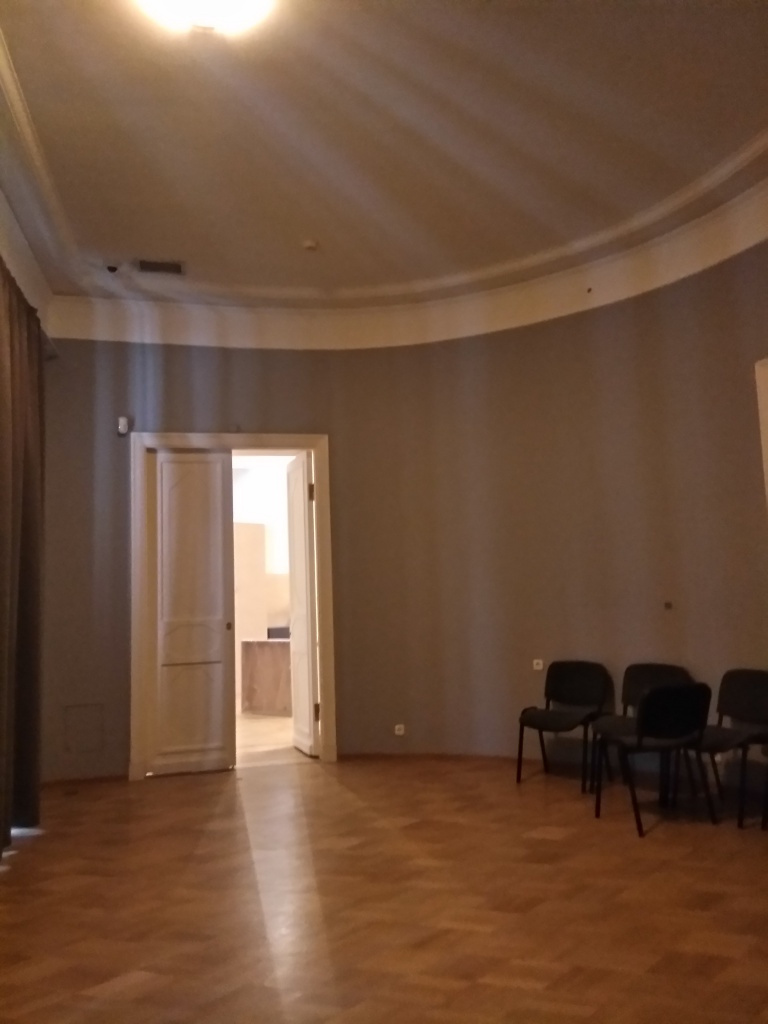 |
| Introductory Hall before the capture of the Museum |
Introductory Hall after the capture of the Museum |
St. Petersburg Hall. The design of the hall, its friezes with architectural images of St. Petersburg, sphinxes, specially designed showcases created the image of the city where Roerich was born, the culture of which he absorbed. The city, where the foundations were laid and understood which thereafter opened up in his creative activity. Photos, documents, drawings and paintings, exhibited in the hall, presented Nicholas Roerich’s creative activity at different periods of his life and disclosed his interests, those of archeology, history, painting and the Orient that would lead him along the life path. Here, in St. Petersburg, Nicholas Roerich met Helena Shaposhnikova, who became his wife. They had two sons George and Svetoslav. Thus the Roerich family was born, a unique family with common interests and creative aspirations, which gave so much to Russia and the whole world.
St. Petersburg Hall today presents the same despondency and emptiness. And the paintings of Nicholas Roerich, suffering on the walls ...
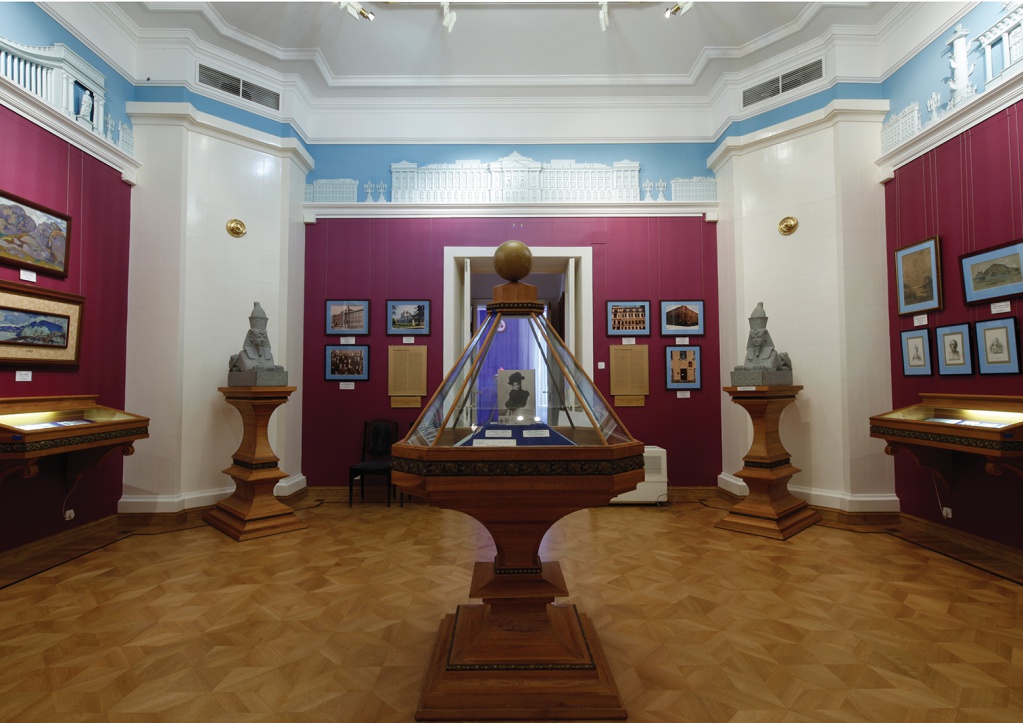 |
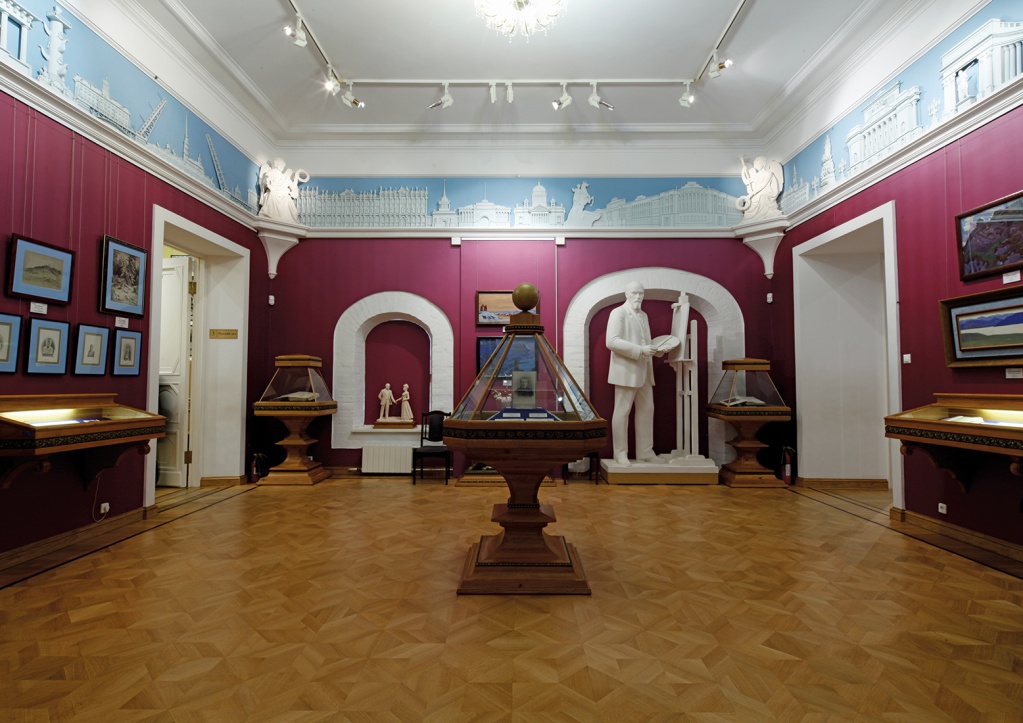 |
 |
| St. Petersburg Hall before the capture of the Museum |
St. Petersburg Hall after the capture of the Museum |
The Russian Hall was dedicated to the image of the Russian Land in the works of Roerich. The paintings, presented in the hall, were created by the artist in different years in different countries, but they all are imbued with love for Russia and faith in its high destiny. A fabulous frieze, carved furniture, colorful dioramas, sculptures, introduced the visitor to the world of pagan and Christian Rus, to the space of its great culture. I’d like to draw your attention to the fact that the design of Russian and St.Petersburg halls was manufactured and donated to the Museum by social activists. Numerous friends and assistants helped to design the Museum at all stages of its establishing.
But the destructors did not want beauty. And respect for other people’s work is alien to them. Wonderful friezes and dioramas were broken, carved furniture spoiled. The image of Russia was erased from the exposition.
 |
 |
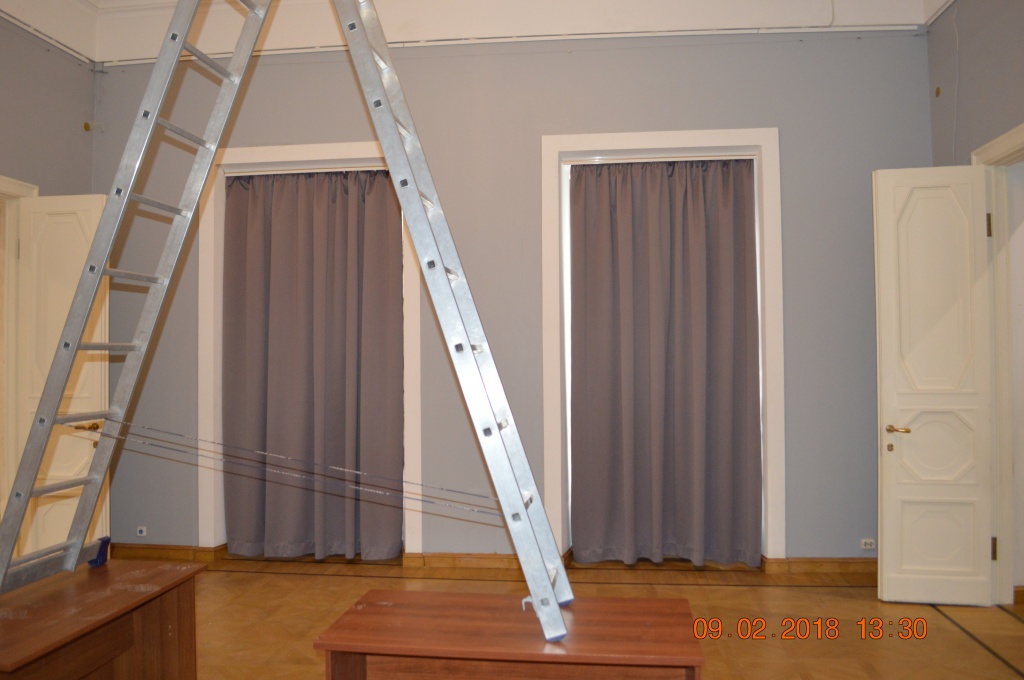 |
| Russian Hall before the capture of the Museum |
Russian Hall after the capture of the Museum |
Hall of Living Ethics was the heart of the Nicholas Roerich Museum. Its exposition contained a deep thought about the unity of man, the planet and the Cosmos. “There is no such knowledge that would not affirm the great bond of the worlds,” the Living Ethics says. “There are no ways that would not lead to the Higher World.” Nicholas Roerich’s shining canvases, bright photos of the Cosmos, paintings and sculptures of contemporary authors, light and music merged in the dark blue space of the hall in a single organic synthesis, introducing visitors to the evolutionary ideas of the Living Ethics, the philosophical system created with the direct participation the Roerichs.
This hall today. There is no color, no light, no music, no space of the Cosmos. The sculptures of the Angels were dislodged and containerized in plywood together with the diorama. “Teachers”, “Agni-Yoga”, “the Singer of Shambhala” were in darkness, in captivity, together with the “Angels”.
 |
 |
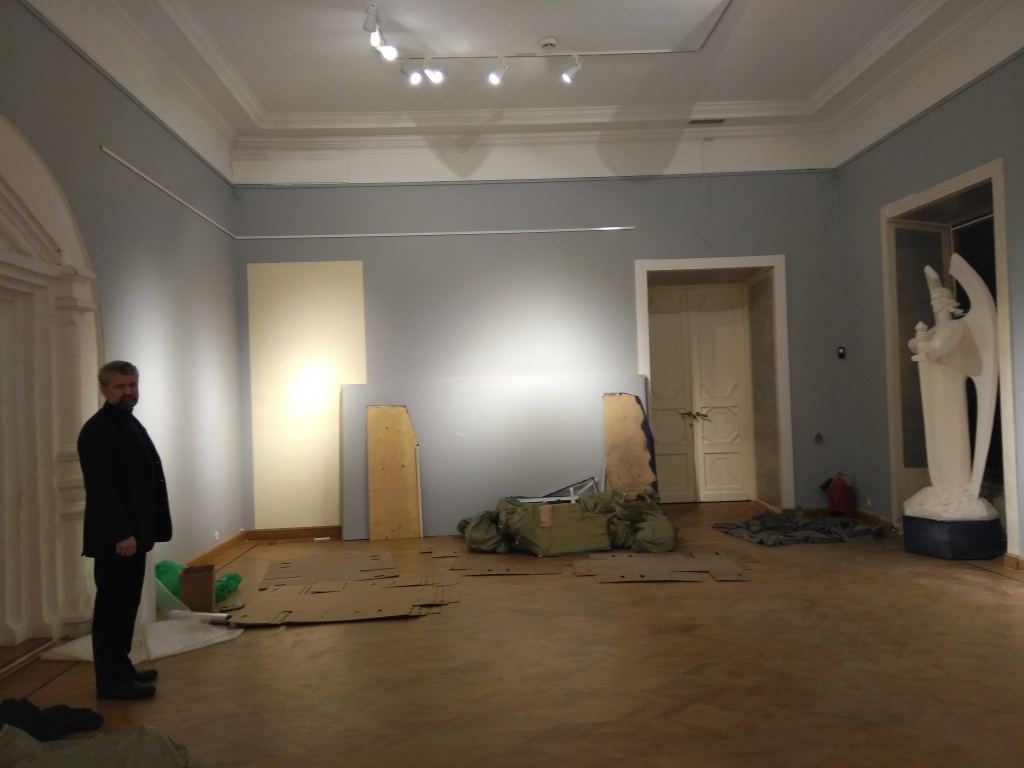 |
| Hall of the Living Ethics before the capture of the Museum |
Hall of the Living Ethics after the capture of the Museum |
Masters’ hall was one of the most beautiful halls of the Museum. It was dedicated to the Mahatmas, the spiritual Teachers of India. Restorers carefully reproduced historical marble columns, a mirror and a chandelier were made by a special order. Roerich’s triptych “Long live the King!”, the pictures of the series “His Country”, drawings of Helena Roerich and unique relics presented to her by the Teacher, as well as a portrait of Helena Roerich painted by Svetoslav Roerich, created a space of spirituality illuminated by Beauty and Light.
Today, we have here the space of the same facelessness, testifying to the desire of the destroyers to ruin everything that elevates a person, that directs him to high ideals.
 |
 |
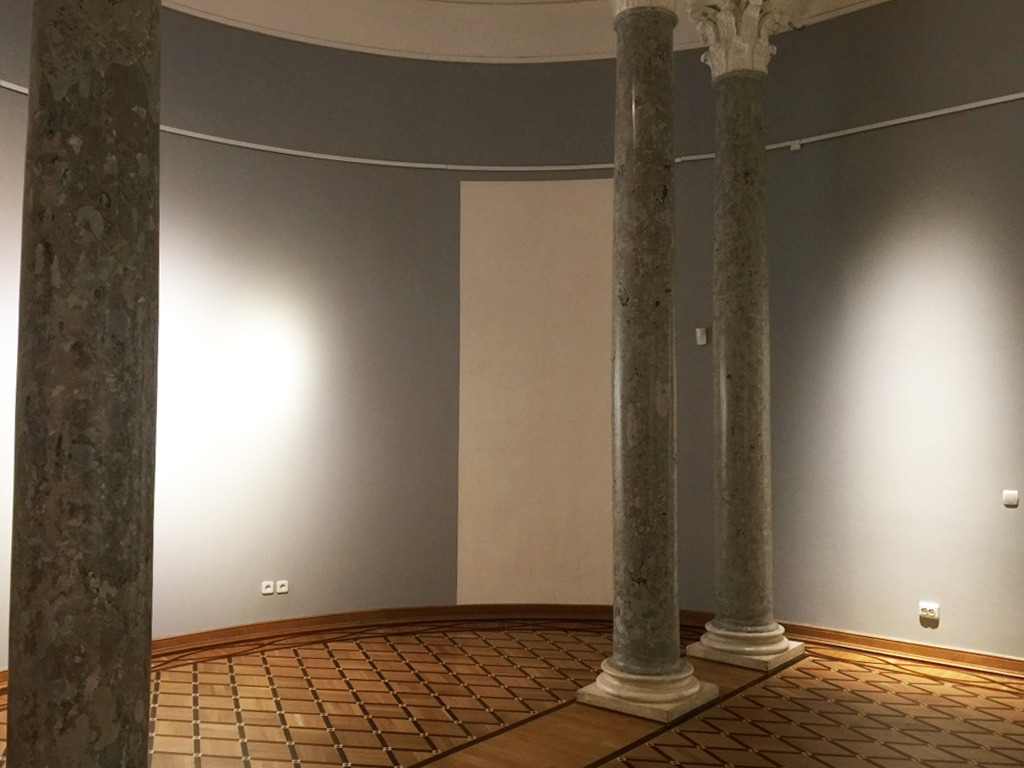 |
| Masters’ Hall before the capture of the Museum |
Masters’ Hall after the capture of the Museum |
Central Asian Expedition Hall told about the famous trip made by Nicholas Roerich, his wife Helena and their eldest son George to the underexplored and impassable areas of Central Asia in 1923-1928. In the exposition of the hall, we saw the editions of travel diaries of Nicholas Roerich, a unique archeological collection assembled by Nicholas and George Roerich in Tibet, shining tops of the Himalayas depicted in the artist’s paintings. The route of the expedition caravan was marked on a three-dimensional map layout, in the creation of which scientists, artists, social activists participated.
There is only a gray sarcophagus instead of the whole exposition …
 |
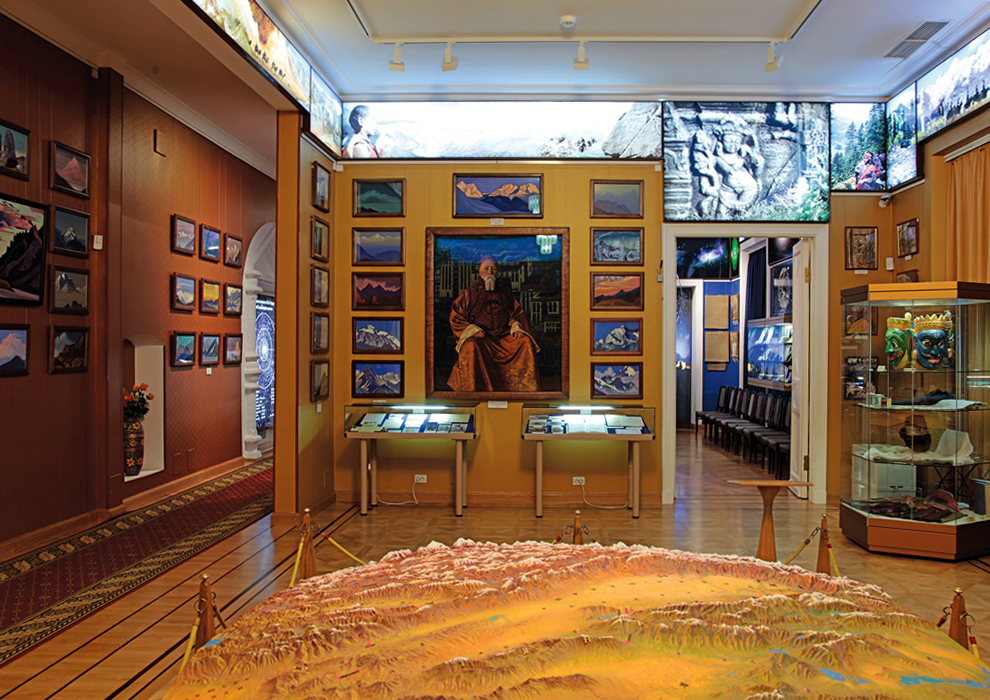 |
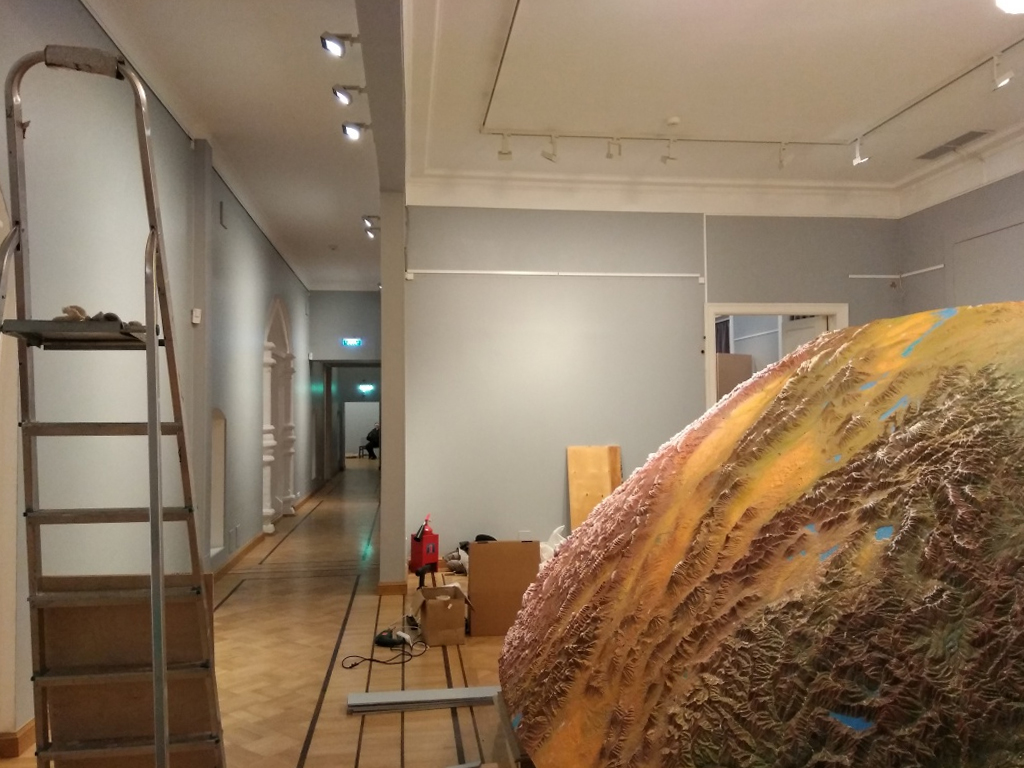 |
| Central Asian Expedition Hall before the capture of the Museum |
Central Asian Expedition Hall after the capture of the Museum |
The exposition of the Hall of Kullu carried visitors to the sacred Himalayan valley of India, where the Roerichs settled at the end of the expedition. Pictures of the Roerichs and luminous friezes, made on the basis of photographs, helped to feel the beauty and originality of this place. The documents, books, memorial items exhibited in the hall made it possible to imagine the tense, multifaceted creative activity of the Roerichs in Kullu. Here they created the Himalayan Institute of Scientific Research “Urusvati”. In Kullu Nicholas Roerich worked out a draft of the Treaty on the Protection of Artistic and Scientific Institutions and Historic Monuments, recognized worldwide as the Roerich Pact.
Here we are witnessing the gray ugliness, in which, thanks to the efforts of modern barbarians, the bright colors of the valley of Kullu, so beloved by the Roerichs, faded away.
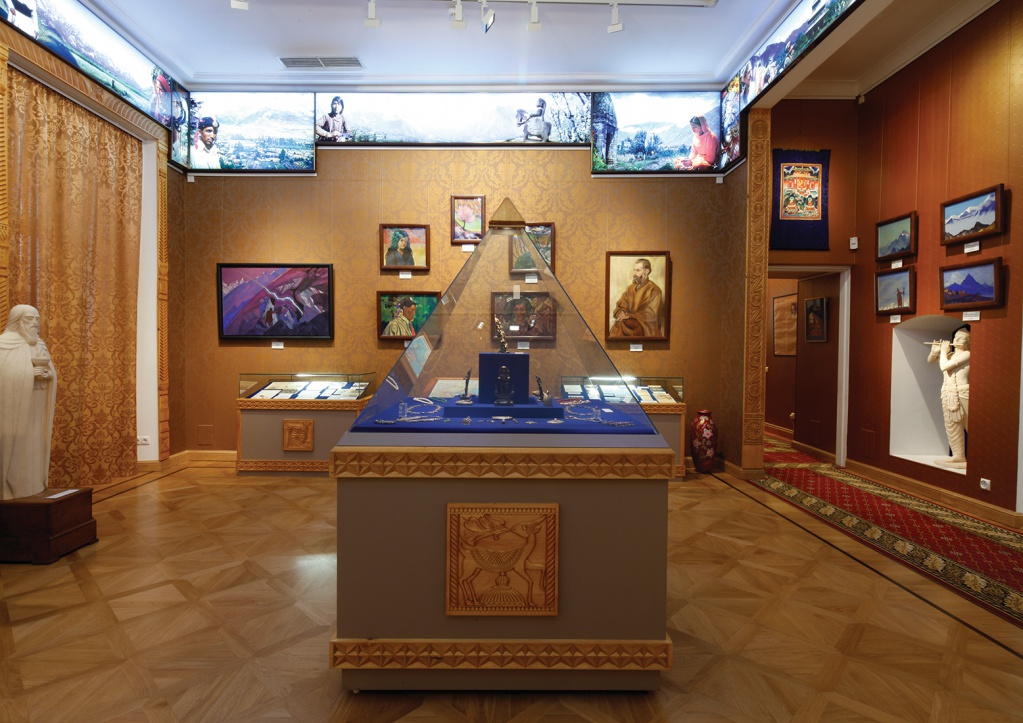 |
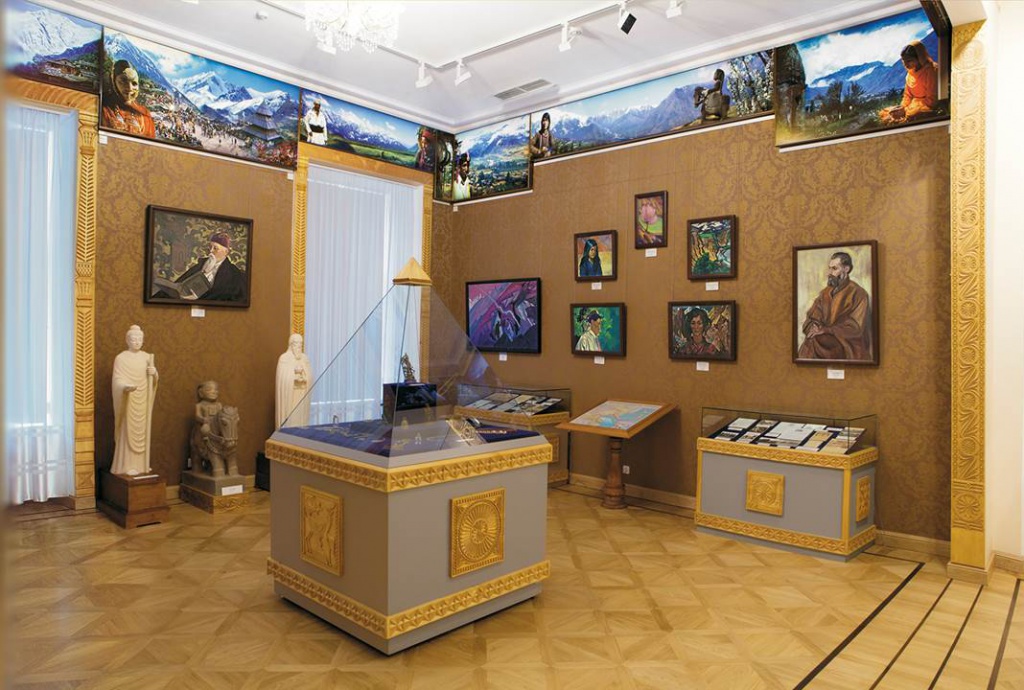 |
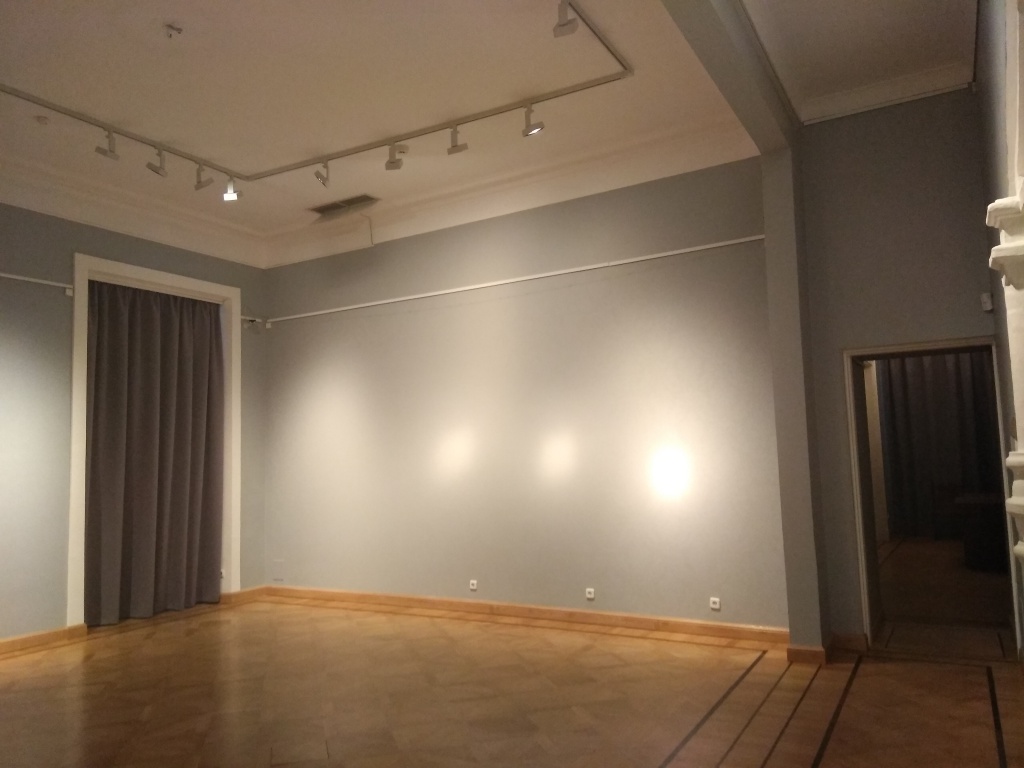 |
| Hall of Kullu before the capture of the Museum |
Hall of Kullu after the capture of the Museum |
The special hall of the Museum was dedicated to the Roerich pact. Photographic documents presented in the exposition told on the promotion and approval of the Treaty. The Banner of Peace was the main unifying exhibit of the hall. The most ancient symbol of humanity, the Banner of Culture, represents three red circles in circumference on the white cloth. It became the distinctive sign of the Pact. The Banner of Peace and the Roerich Pact call for protection of cultural values during the war and in peacetime, for, as Nicholas Roerich believed, the destruction of Culture is the destruction of the foundations of the further evolution of mankind.
The exposition of the hall of Banner of Peace was destroyed in the same way as the exposition of other halls. Vandals do not need Culture. Therefore, the first thing they did after the armed seizure of the Museum was to remove the Banner of Peace from the flagpole of the Museum secretly, under the cover of night …
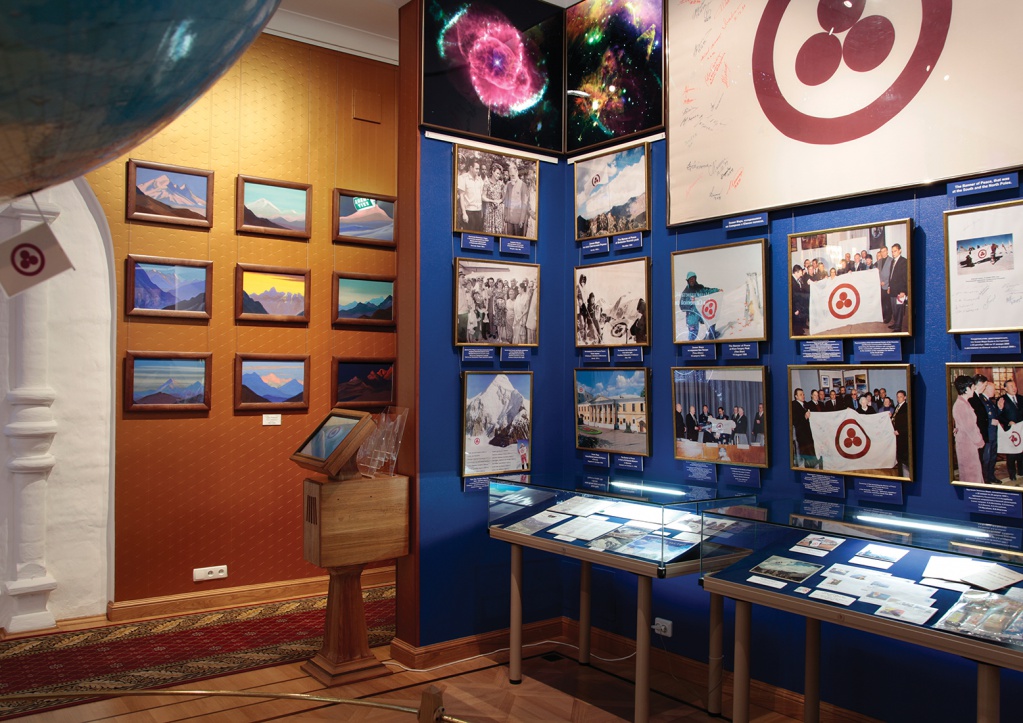 |
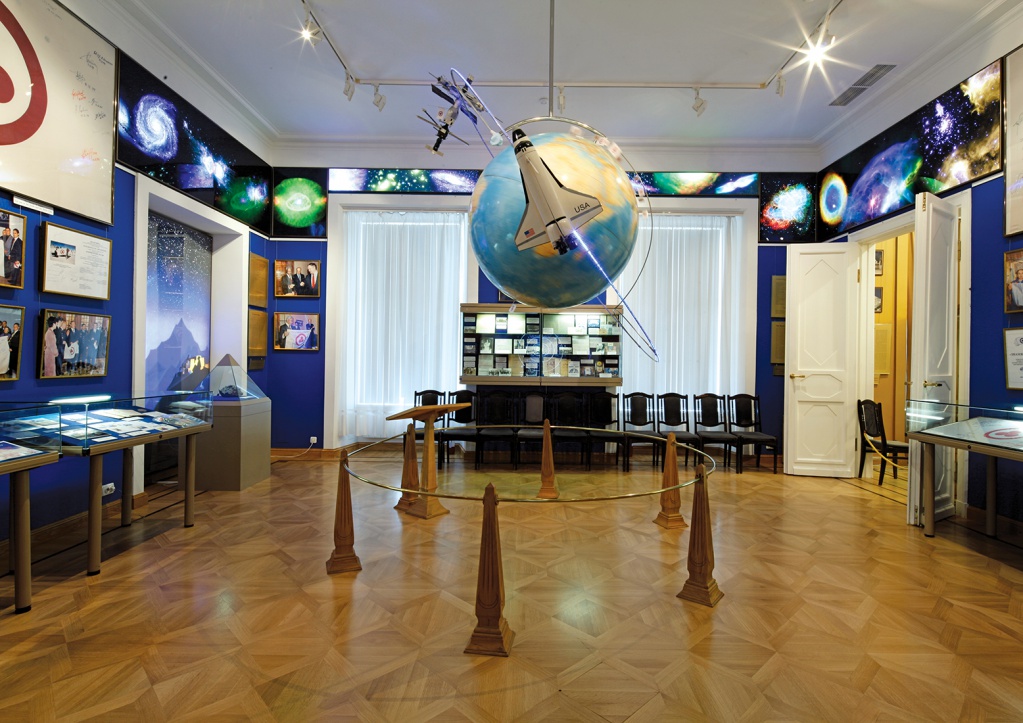 |
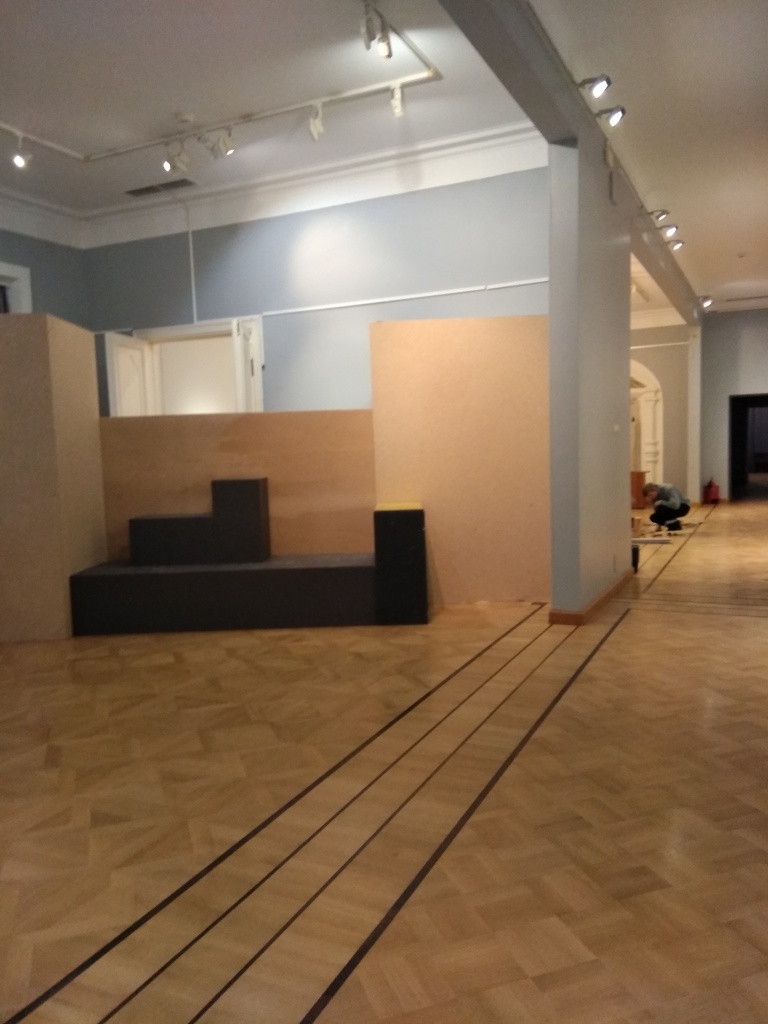 |
| Banner of Peace Hall before the capture of the Museum |
Banner of Peace Hall after the capture of the Museum |
Two halls in the Museum were dedicated to the sons of Nicholas and Helena Roerich.
The hall of George Roerich, the eldest son, an Oriental scholar, linguist, historian, archaeologist, one of the greatest enclopaedists of the West and the East, was opened in 2012 to the 110th anniversary of George Roerich’s birth. Photos, documents, children’s and youthful drawings, books and personal belongings presented in the exposition reflected the multifaceted creative interests of George Roerich and helped to recreate a comprehensive identity of the inspired scientist, thinker, traveler.
 |
 |
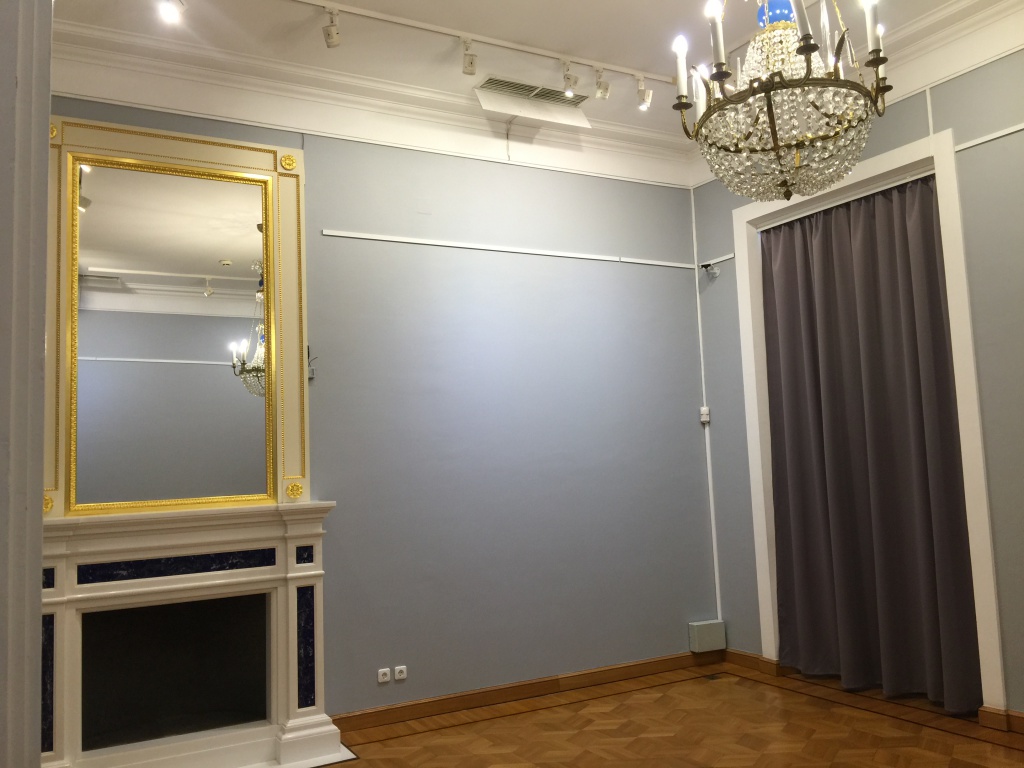 |
| Hall of George Roerich before the capture of the Museum |
Hall of George Roerich after the capture of the Museum |
In the hall dedicated to Svetoslav Roerich, the youngest son of the Roerichs, his scenic paintings, those of portraits, landscapes, paintings dedicated to India and Tibet, philosophical paintings were presented. All his creative work is light-colored, it is imbued with harmony and beauty. “Let's strive for the Beautiful”, these words became the motto of his whole life.
 |
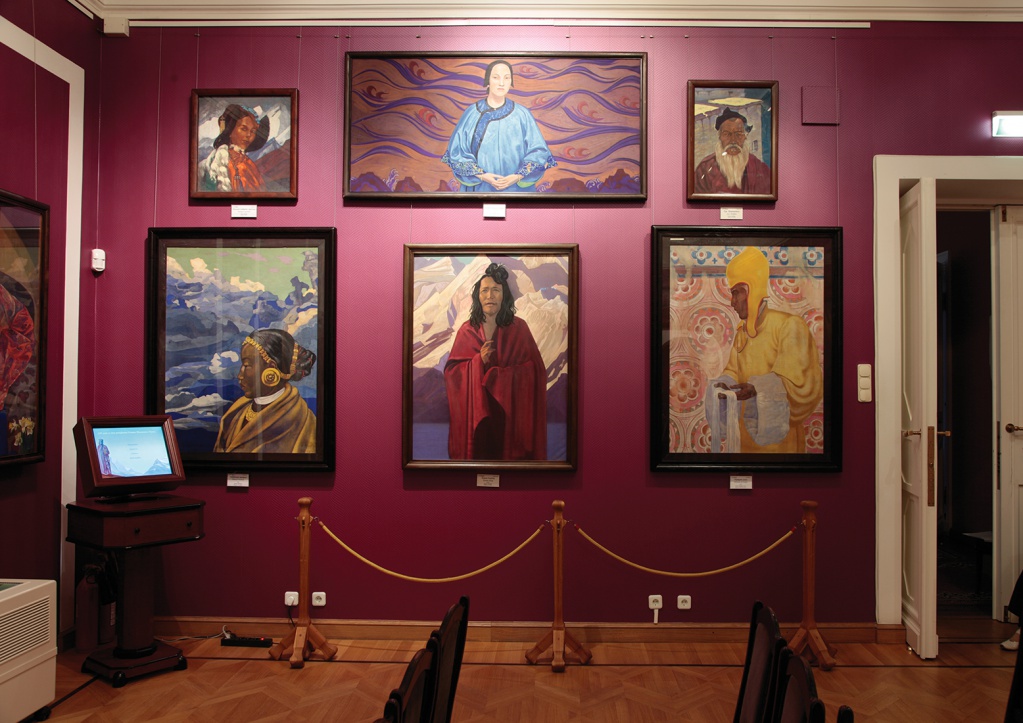 |
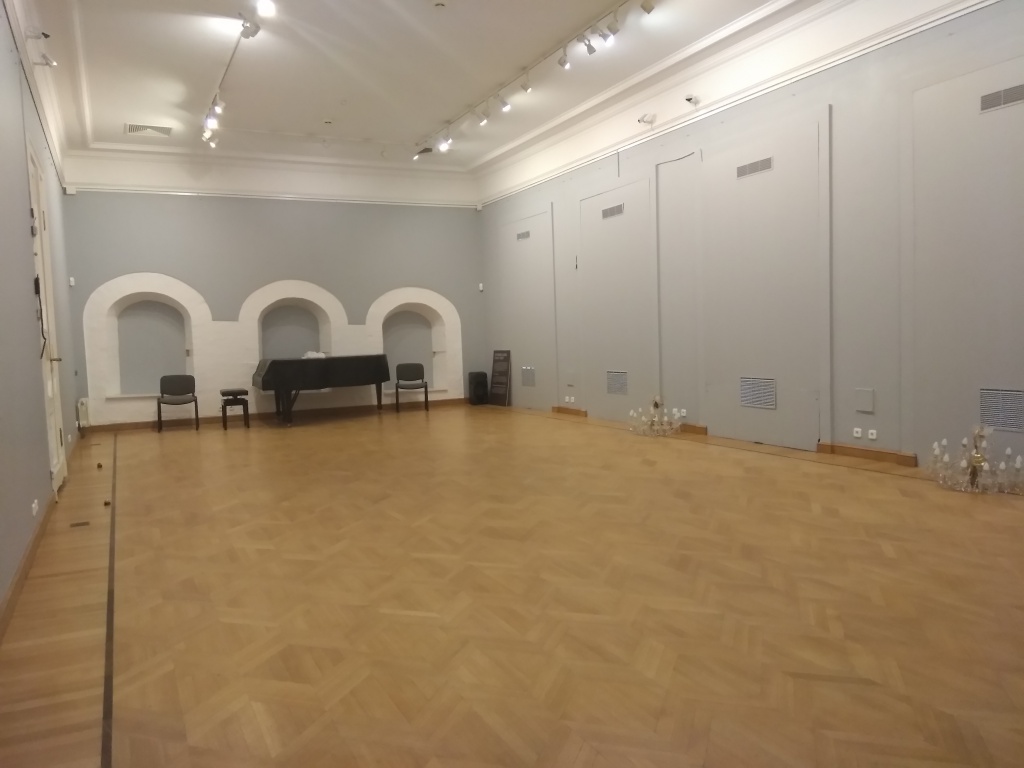 |
| Hall of Svetoslav Roerich before the capture of the Museum |
Hall of Svetoslav Roerich after the capture of the Museum |
Svetoslav Roerich took part in all undertakings of his family. Transferring the heritage to Russia for the creation of the Museum, he fulfilled the covenant of his parents. Svetoslav Roerich’s testament was fulfilled by Lyudmila Shaposhnikova. She created the Museum, which truly became the “Power of the Roerichs” and a new phenomenon in the museum world, as it carried the ideas of cosmism, contributing to the expansion of consciousness and creation of a new cosmic mindset. Once Nicholas Roerich wrote about Chiurlionis, “He is not an innovator, but a new one himself.” These words can rightly be referred to Lyudmila Shaposhnikova and to the Museum created by her. Lyudmila Shaposhnikova for her great contribution to the development of museum studies and the preservation of cultural heritage was awarded the Order of Friendship in 2006.
In 2017, the axe fell on the Museum created by her. For what? Does anyone get better after that execution? Maybe it was done for those visitors who came to the Museum again and again and left the words of admiration in the Guestbook? Or, perhaps, for Russia, in which the Roerichs believed and for which they worked? Did Svetoslav Roerich dream of such a fate for a non-governmental museum named after his father?
The largest non-governmental museum was not just destroyed, it was abused, cynically and cruelly. The Museum created with love by people from different parts of Russia and the whole world was rudely destroyed. It was destroyed by those who had to defend and support it, by the Minister of Culture Medinsky and his deputies, who gathered around people, unburdened by the confines or morality and conscience.... But this is not the worst thing! Is it terrible that this execution was carried out with indifferent silence or tacit consent of cultural community, museum workers, intelligentsia. In this silence all our appeals for help were drowned ...
Pavel Zhuravikhin, First Deputy Director General of the Non-Governmental Nicholas Roerich Museum
You saw into what a once beautiful exhibition of the Non-Governmental Nicholas Roerich Museum turned. Tens of thousands of people from all over the world came to look at the exhibition. But this is so to say the external side of destruction of the Non-Governmental Nicholas Roerich Museum of the ICR, open to the public. But there is still a closed, inner side of the museum destruction, hidden from public view. It is hidden from public view in basements and closed premises, which have become a kind of prison for the slaughtered, broken and mutilated equipment of the Non-Governmental Nicholas Roerich Museum, its unique elements of exposition, the furniture of the halls, which were aesthetic component of the museum space, created under the guidance of Lyudmila Shaposhnikova, the authorized representative of Svetoslav Roerich, by the ICR staff with the participation of thousands of people who contributed their donations to the development of the Museum and its activities.
On January 15, 2018, within the framework of the court judgement procedures to evict the ICR from two museum buildings of the Lopoukhins' Estate those of the Main House and the wing, the staff of the ICR was admitted to the territory and a part of the premises for the first time in nine months. I have to say that we on several occasions requested to the Ministry of Culture and the State Museum of Oriental Art to incorporate our members into the commission, which, according to the director of the State Museum of Oriental Art V.Sedov, was established “for descripting, recording and accounting of proper preserving museum valuables, movable and immovable property located in the Lopoukhins’ Estate” and transferred to the custody of the State Museum of Oriental Art. What we saw in January can be called a terrible picture of abuse of property and exposition of the truly people’s Museum named after Nicholas Roerich. Actually, long years of public endeavour to develop the culture of Russia were cynically trampled and torn to pieces.
 |
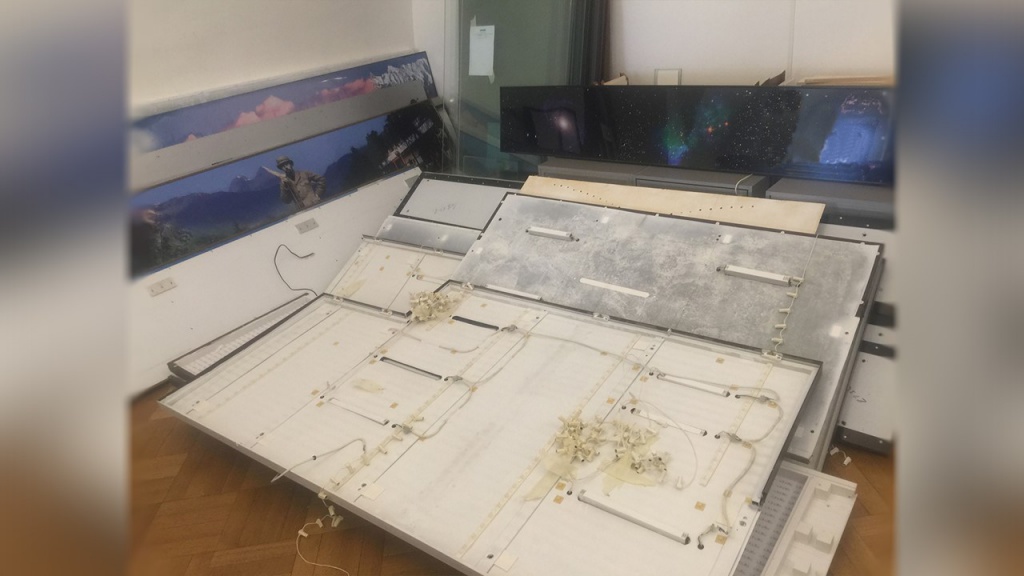 |
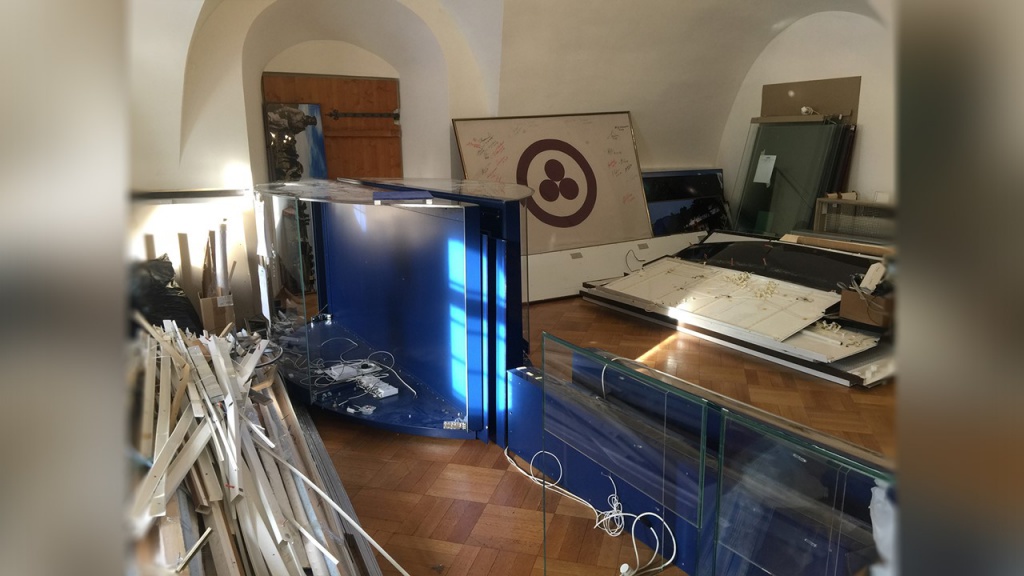 |
|
| Elements of exposure |
Broken friezes |
Part of destroyed exposition |
The director of the State Museum of Oriental Art V.Sedov and his deputy, the so-called director of the State Museum of the Roerichs T.Mkrtychev called their actions “responsible storage”. We will show the recorded facts of vandalism and intentional destruction of our Museum’s exposition objects.
Entrance area of the Museum. Completely broken interiors of entrance area of the Museum.
 |
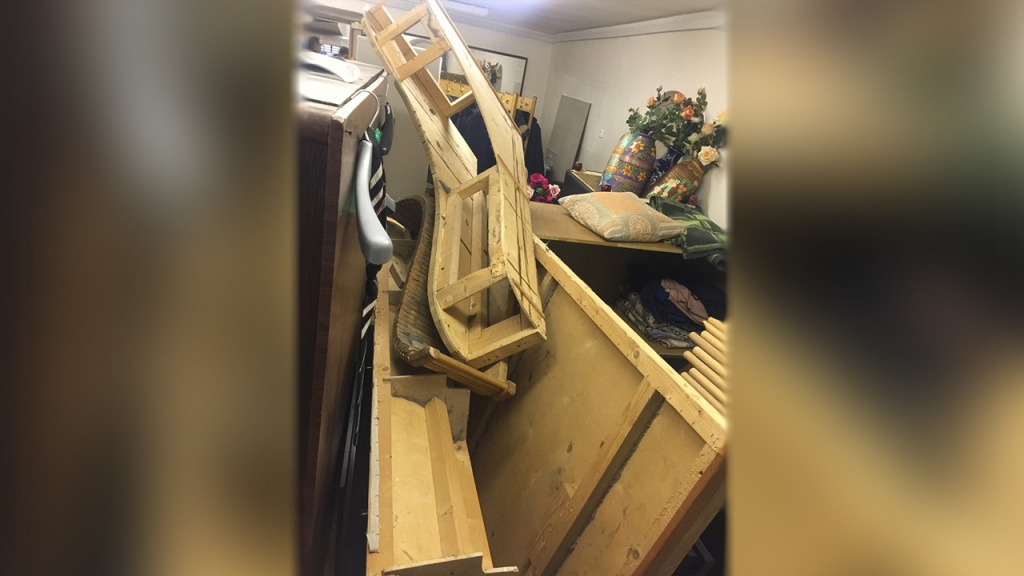 |
|
| Entrance area of the Museum |
Broken parts of entrance area |
Russian Hall
 |
 |
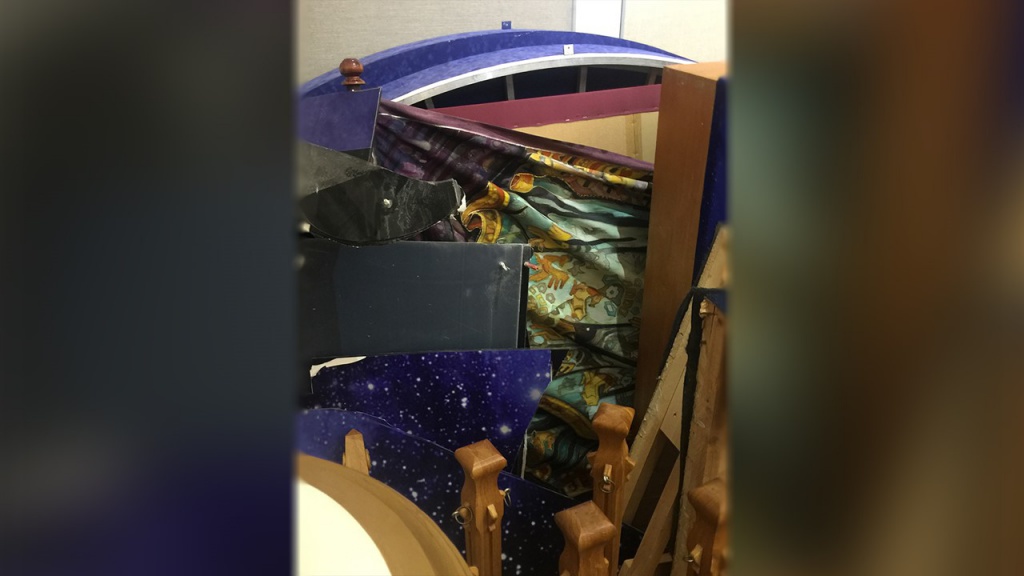 |
|
| Russian Hall |
The piece of artwork “The Queen of Heaven” |
Parts of destroyed work “The Queen of Heaven” |
Nicholas Roerich made a great contribution to the development and preservation of Orthodox culture. In 1903 he painted the Temple of the Holy Spirit in the Estate of Princess Tenisheva in Talashkino near Smolensk. The altar painting of the church called ”The Queen of Heaven”, an image of Universal Love and Compassion became its central part. During the Great Patriotic War the painting was destroyed by the fascists. In 1999, in commemoration of Nicholas, Helena and Svetoslav Roerich’s anniversary, our Museum was presented with a copy of the artwork “The Queen of Heaven”, made according to the sketch of Nicholas Roerich. Here you can see what the State Museum of Oriental Art made with this exhibit of the museum. All wood carving was broken. The screen of the electronic information tray was also broken.
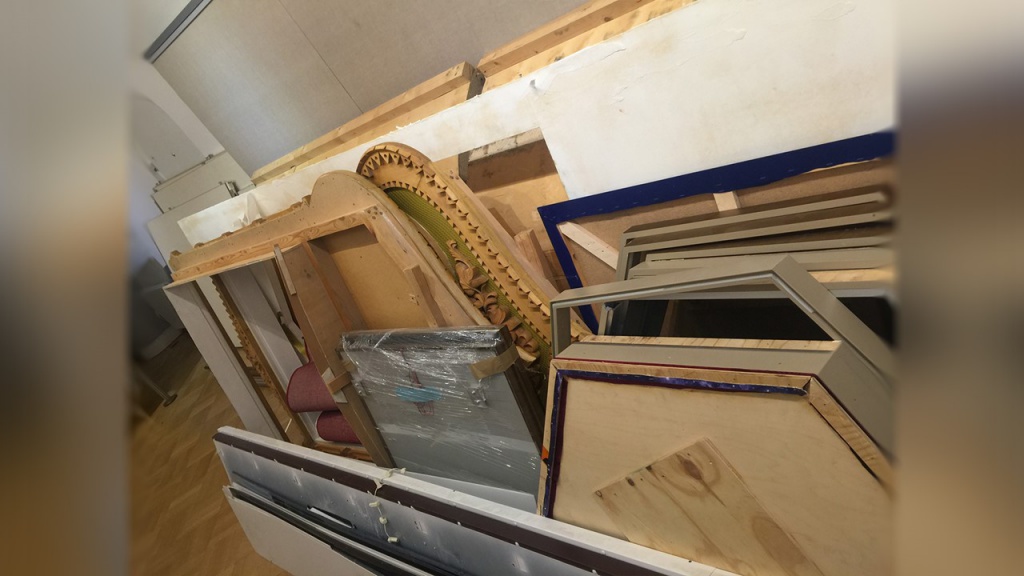 |
 |
|
| Parts of carving of Russian Hall |
Broken electronic tray |
Banner of Peace Hall
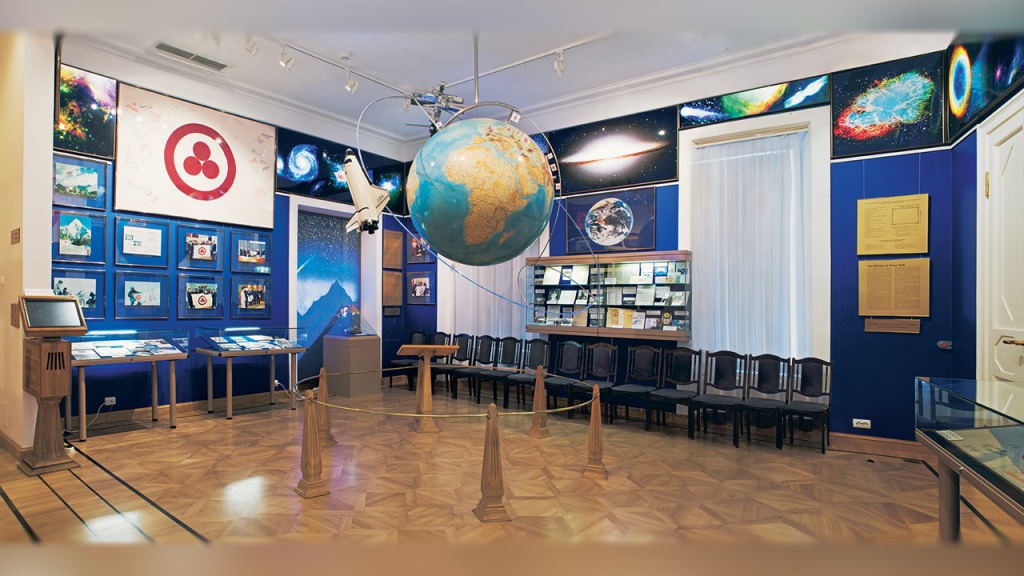 |
|
Banner of Peace Hall |
|
Banner of Peace hall was dedicated to the outstanding peacekeeping activity of Nicholas Roerich in preserving world cultural values. The Banner of Peace became the symbol of protection of world culture monuments from destruction. It is the official flag of the Roerich Pact, it represents three connected red spheres on the white field in a circle symbolizing eternity, as a sign of succession of the cultural accumulation of the past, present and future. One of the Banners located in this hall was at the South and North Poles of our planet. Another one was on board many international expeditions, functioning on board the space station “Mir”. Pay attention to the friezes with photos of Galaxies.
Now the Banners of Peace were thrown on the floor. It as an eloquent evidence of the violation of the rights of culture and disregard for the international symbols of cultural protection. Space friezes were also completely broken.
 |
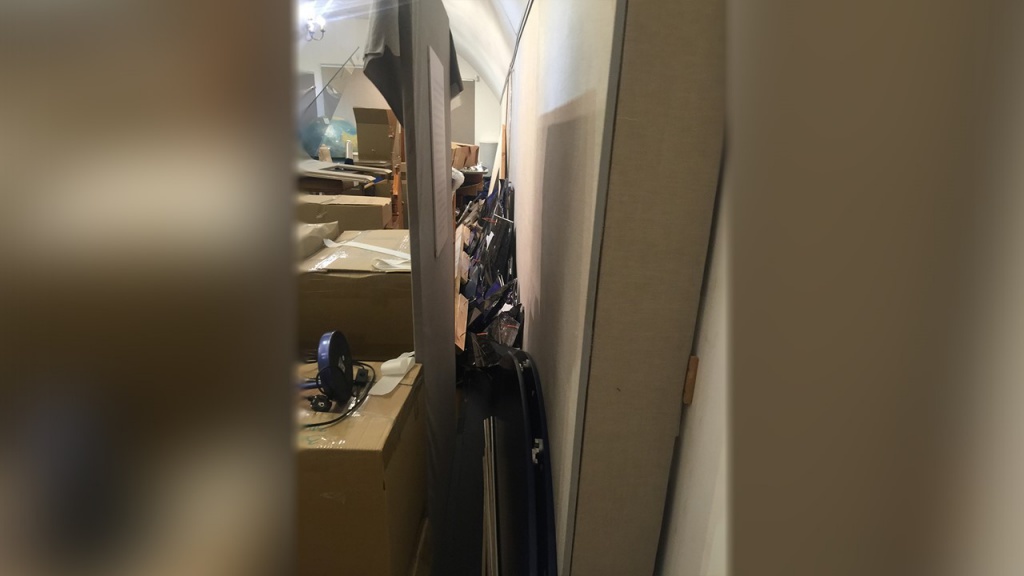 |
|
| The Banner of Peace that was in space, at the North and South poles |
Broken parts of glass friezes |
 |
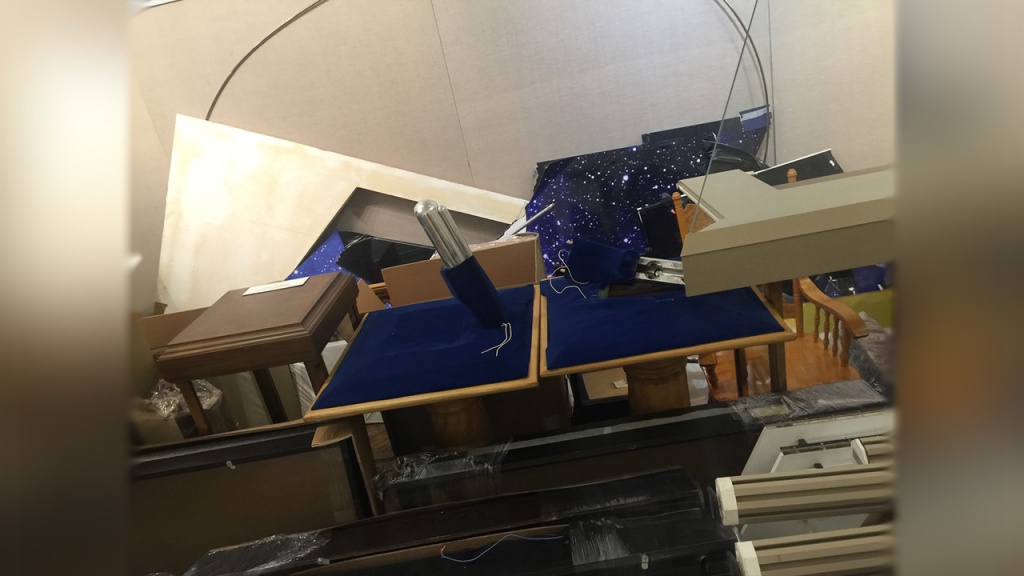 |
|
| Broken globe and the parts of the exhibition |
Broken parts of glass friezes |
Hall of Kullu
The showcase with Helena Roerich’s priceless jewelry and antiques of Tibetan art made of bronze, was completely destroyed. There was only one glass remained.
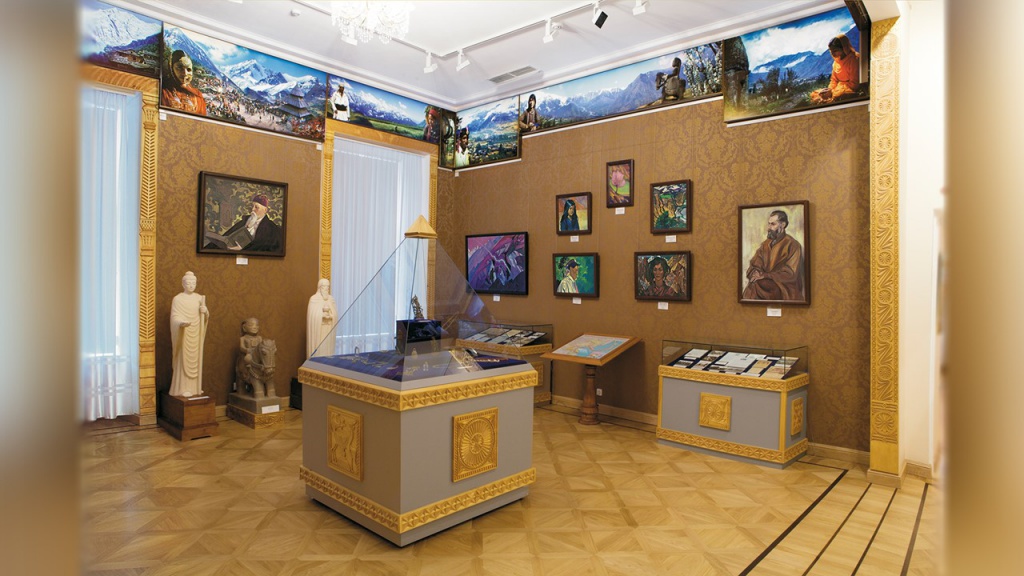 |
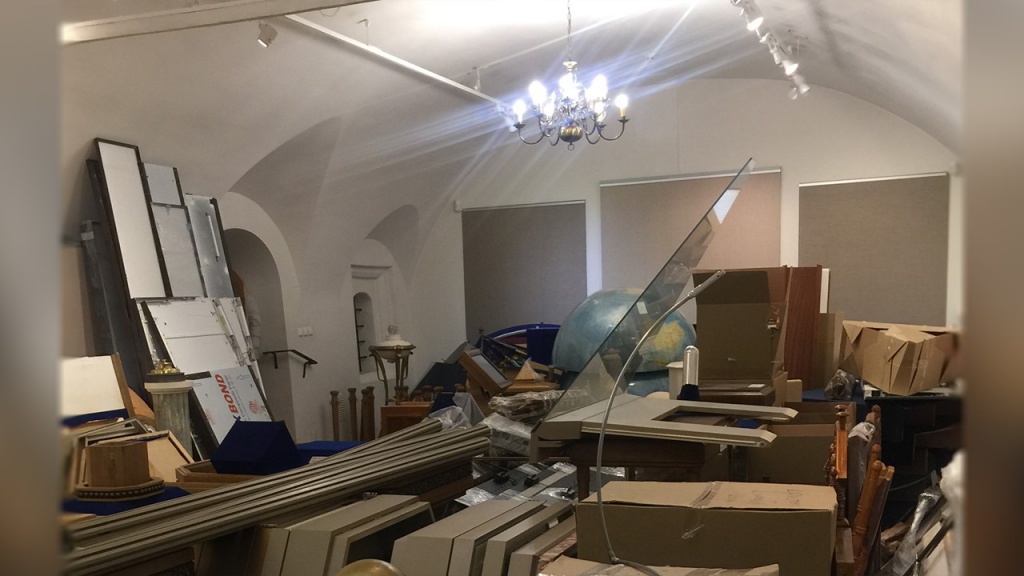 |
|
| Hall of Kullu |
Ruined showcase of Hall of Kullu |
Hall of the Living Ethics
In the showcases of this hall there were ancient Tibetan tankas of the 17-18th centuries, books from the Roerichs’ memorial library, including the first editions of the books of the Living Ethics, the memorable gifts of the Teacher of the Roerichs.
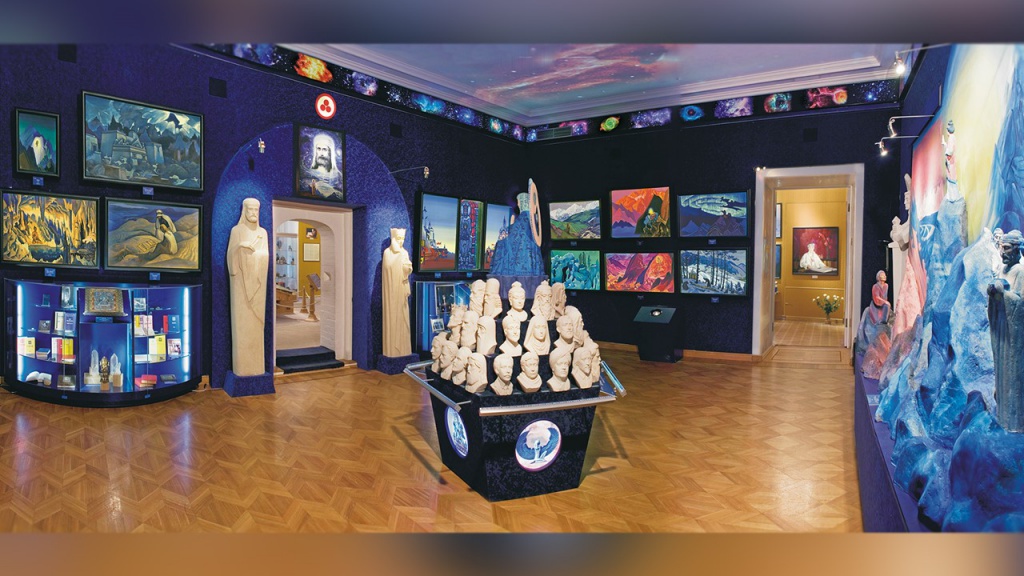 |
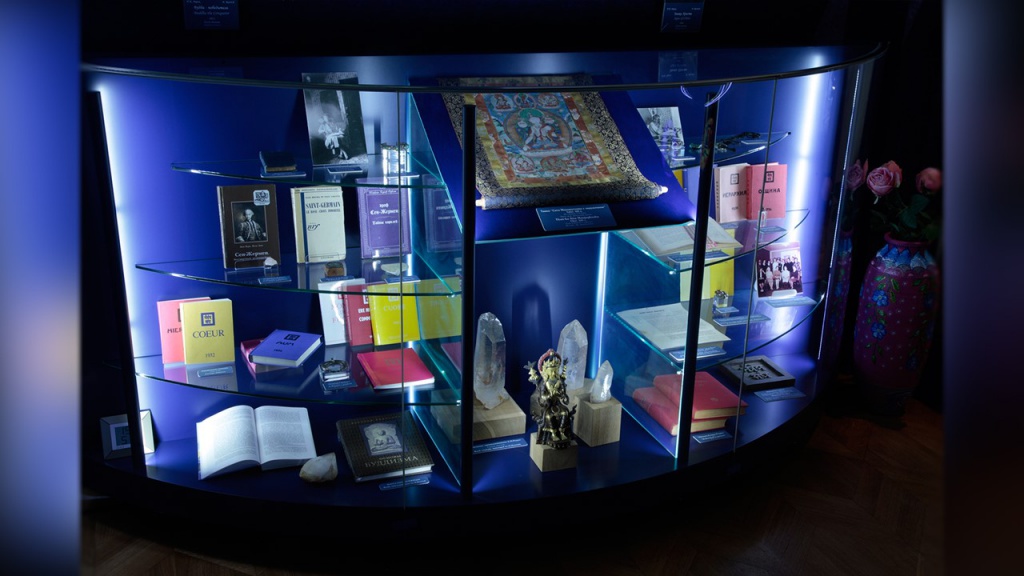 |
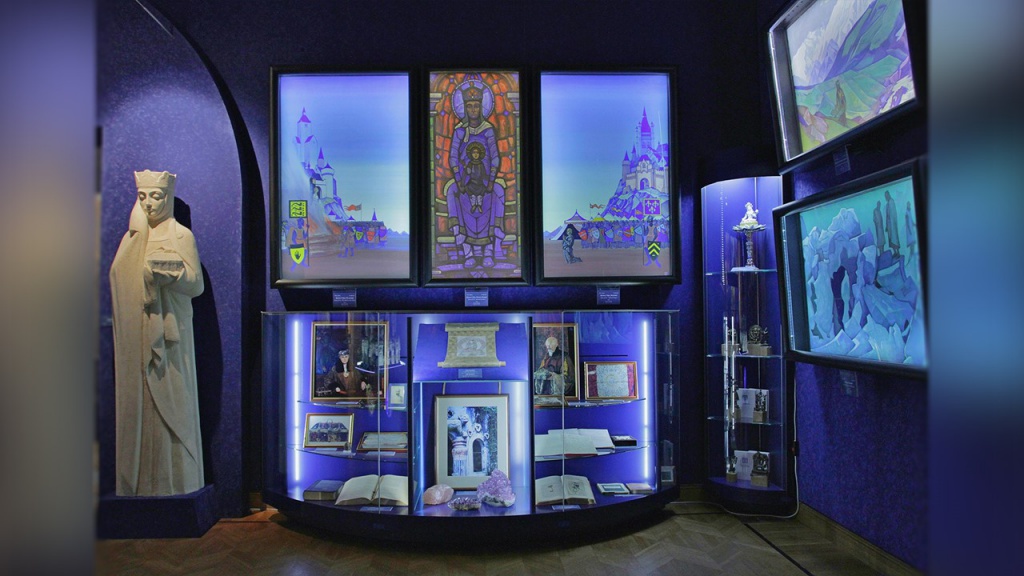 |
|
| Hall of the Living Ethics |
Antivandal showcase |
Showcase in the hall exposition |
These anti-vandal showcases, the cost of which was one million rubles each, were made on the basis of an individual order of the ICR in Germany by the well-known Kunstverk firm. This was a unique museum equipment. By their construction they shall be locked in maintaining. The employees of the ICR with keys were not allowed to dismantle this equipment. Vandals from the State Museum of Oriental Art cut down the hinges by the cutter but still failed, since the showcases were fitted with hidden hinges. Traces of hacking witness that the vandals tried to break the showcases with a crowbar. After they hit the showcases and, although they were made of a shockproof triplex, they beat with such force that it even cracked. Finally, having found the keys of the showcases, they managed to open the locks, forever disfiguring the most valuable museum equipment.
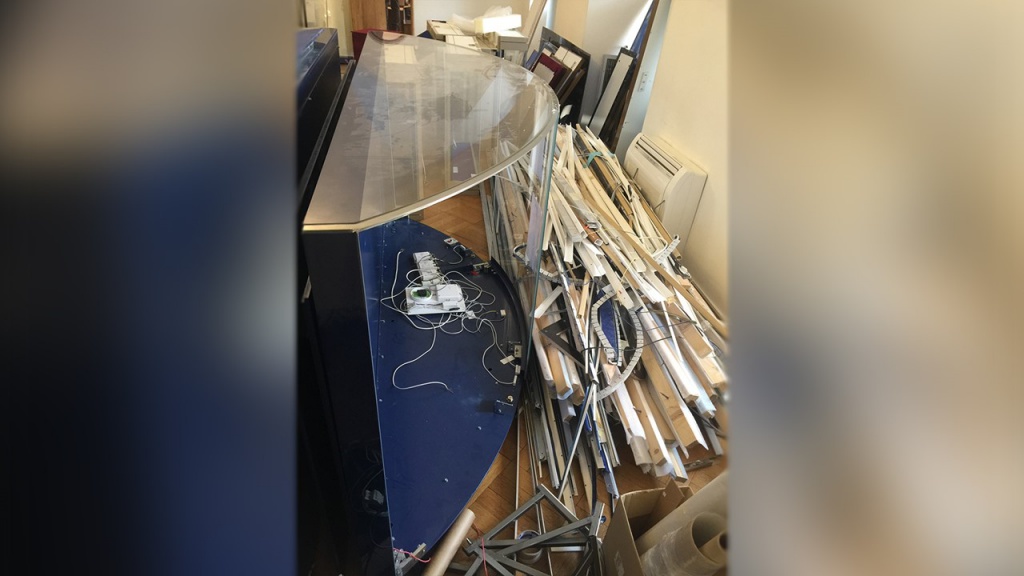 |
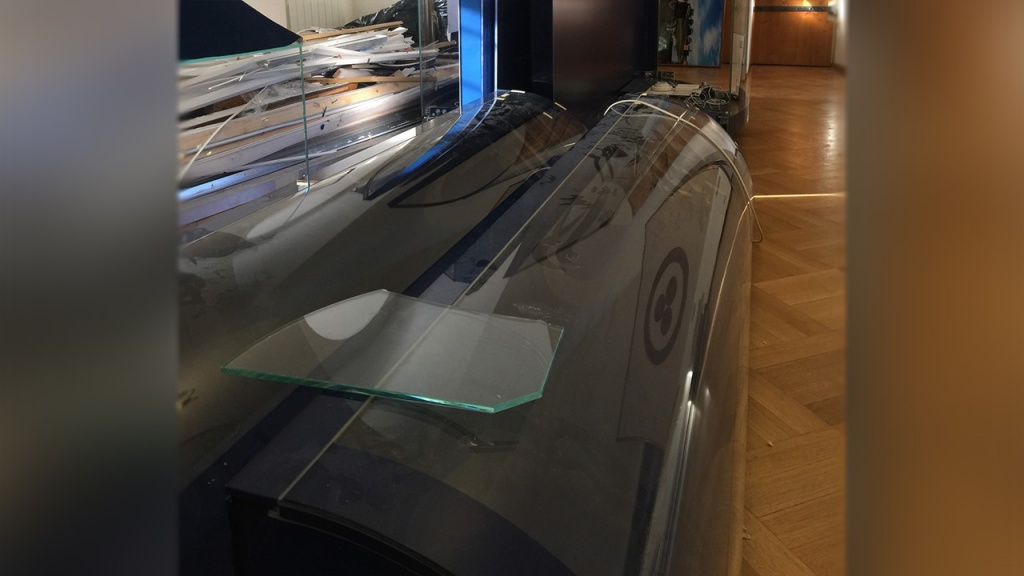 |
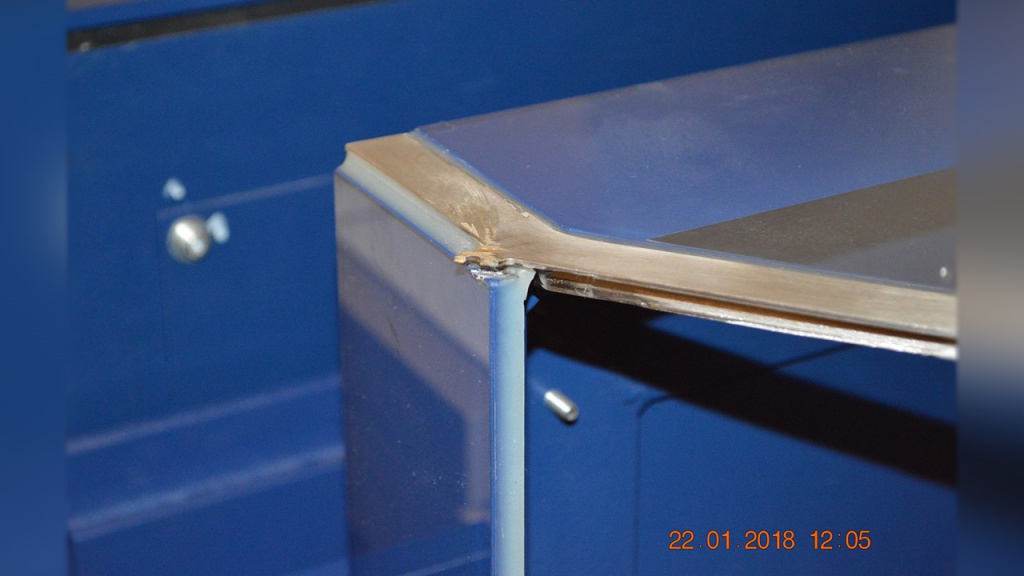 |
|
| Broken showcase |
The part of the showcase |
Cut down hinges of the showcase |
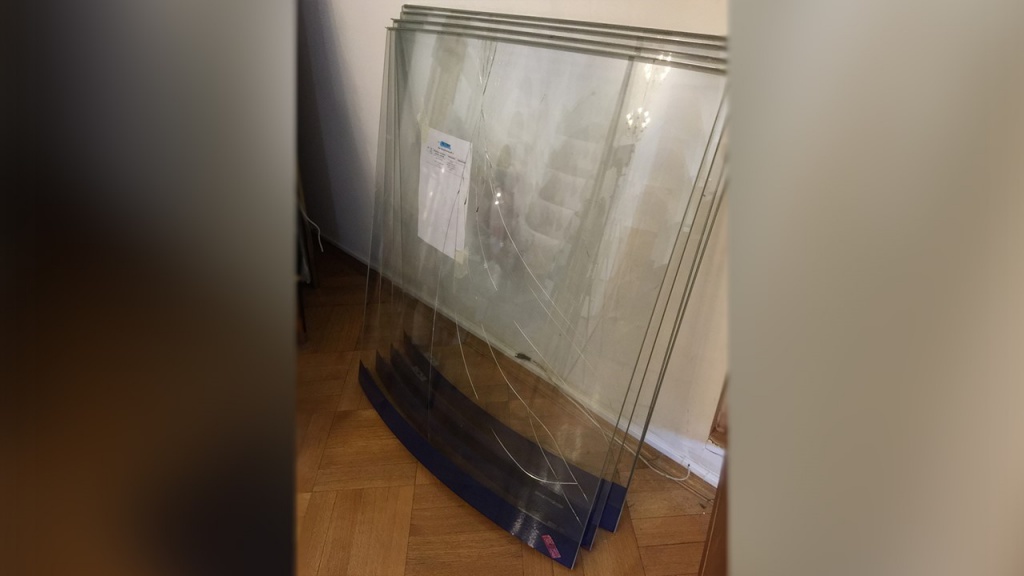 |
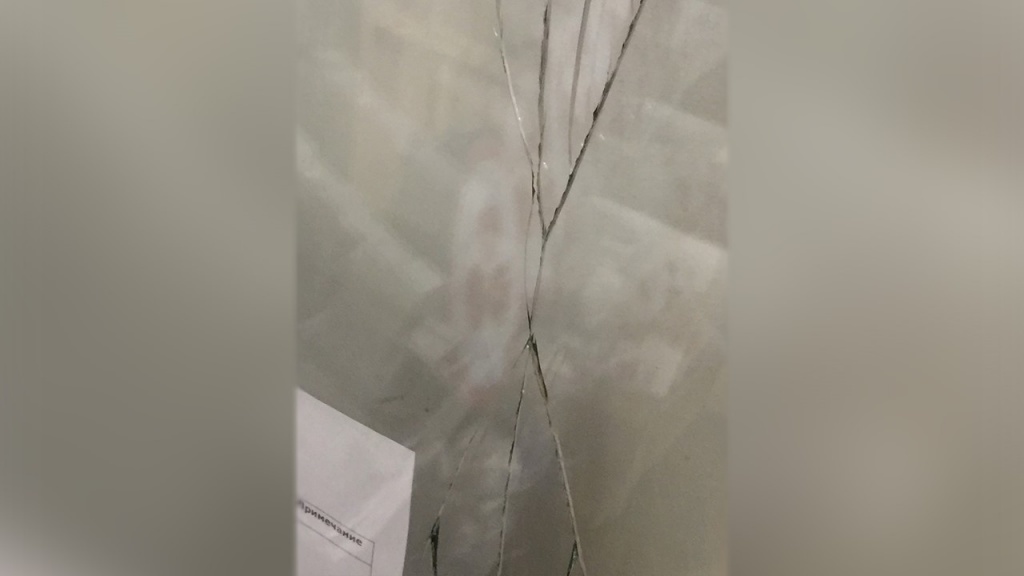 |
 |
|
| Broken showcase |
The showcase in focus |
Broken showcase |
Buddhist Stupa
This is one more museum exhibit, about which I want to talk. The unique Buddhist Stupa of the Three Jewels. Until the fall of 2017 the Stupa was the only Buddhist Stupa in the Russian capital, created by all Buddhist canons. By its content it is rightly a Buddhist shrine. It contains the relics of two hundred outstanding teachers of Buddhism. Among them are the sacred relics, those of ringsels of Buddha Kashyapa and Buddha Shakyamuni, which are more than two and a half thousand years old.
To worship the Stupa and simply to see it the Buddhists from all over the world, as well as Russian and foreign tourists, came here every day. For 9 months now, the access to the Stupa was banned, and the Stupa now is in poor condition, literally in a state of total disrepair.
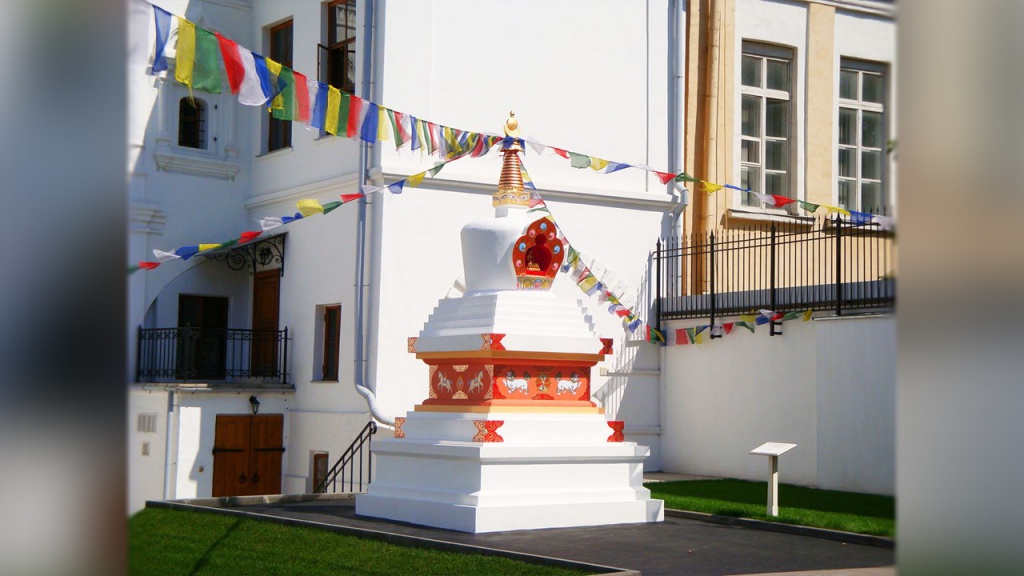 |
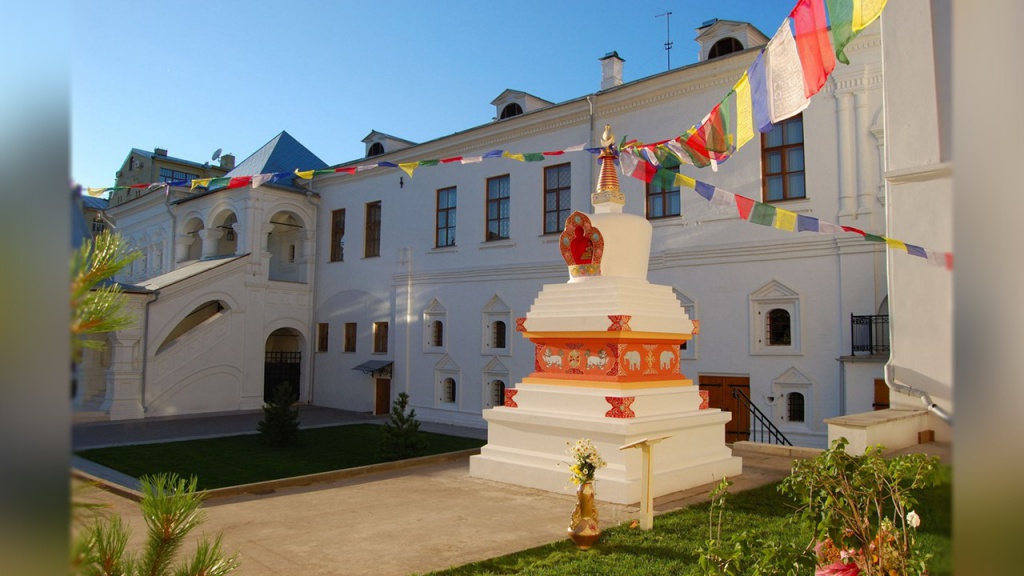 |
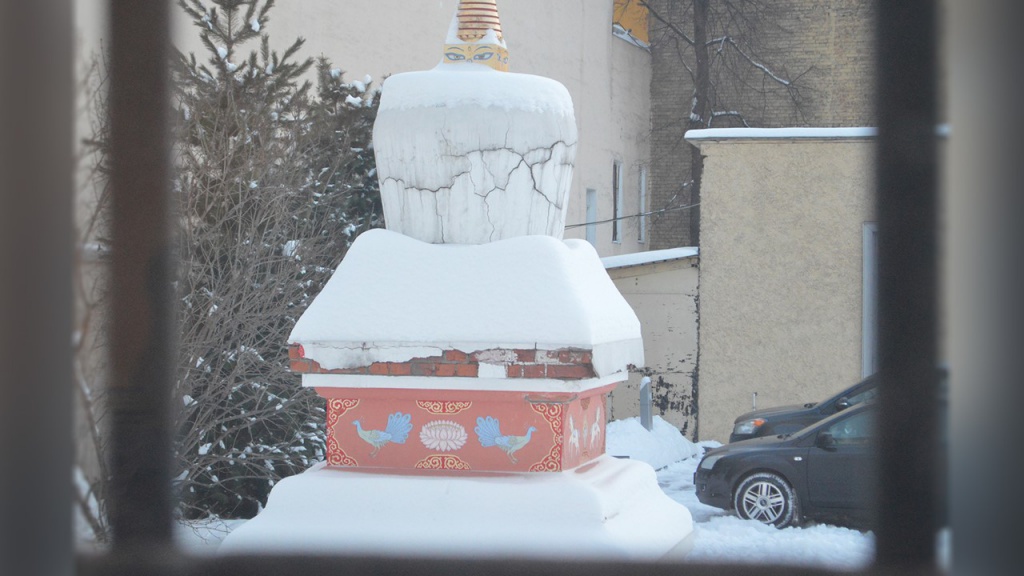 |
|
| Buddhist Stupa before the capture of the Museum |
Buddhist Stupa before the capture of the Museum |
Buddhist Stupa after the capture of the Museum |
In conclusion, I‘d like to say that if we think of ourselves as a civil society, then of course we will not remain silent and should not remain silent, in the face of such vandalism, because such crimes are committed against the Museum of outstanding figures of world and national culture, those of the Roerichs and their Heritage. If we remain silent and leave this impunity unheeded, then, accordingly, this impunity will become the basis for the disintegration of society, our State and its people.
The Moderator of Press Conference
Colleagues, questions!
A.Semenets
“Rosbalt” News Agency, Anna Semenets. To sum it up, I’d like to make clear. Am I right to know that you, the staff of the Museum, for 9 months had no access to the Museum, in fact, to your personal belongings. And now, you are allowed to take back your personal belongings. These are just only personal things, aren’t’ they?
A. Stetsenko
The fact is that nothing was allowed to be taken back. Only thanks to our employees’ filing lawsuits in court the items of personal things recovering were being considered. And something was returned only since last December.
A.Semenets
They allowed to take back only personal belongings, didn’t they?
A. Stetsenko
Yes, they did.
A.Semenets
Am I right that they do not want to return the personal belongings?
A. Stetsenko
Right you are. On a lot of spurious grounds. Now we are faced with the fact that they packed up all our things in several boxes and said, “You will take it together with the property.” As we believed, the employee, in theory, was to be admitted to the workplace, to pack his own property and take it out. Instead, the staff of the State Museum of Oriental Art managed our personal things, sorted everything, and transferred it.
A.Semenets
What is the fate of canvases? They were transferred to the Museum of Oriental Art, weren’t they?
The attorney at the ICR Dmitry Kravchenko
At this stage, all the property of the ICR, absolutely everything together with the property that was in the building was transferred to the State Museum of Oriental Art for safekeeping. This is what we know. The regime of custody is provided for material evidence. Apparently, the building was recognized as physical evidence in the Master Bank case. Together with the slippers of employees and all the rest, with all the property.
Just the day after tomorrow, Court will consider one of complaints in relation to the Central Investigation Department of the Ministry of Internal Affairs, aimed precisely to get an information what’s on with our property. Because all the property belongs to the ICR, those of paintings, equipment, and documents. All our documents, those of donatives, the documentation on the ICR activity remained there. And, accordingly, we are asserting our claims against the Ministry of Internal Affairs to give at least the information in what status our property is. At the moment we are actually deprived of this property, and don’t know in what status it is now. We, naturally, consider it our own and there are no grounds to think differently. But legally we have not yet been told in what status this captured property is at the moment.
A.Semenets
You said that this is one of the cases. Could you list what kind of appeals, what statements and in which courts were filed? What issues are you currently considering? And one more item. I would like to understand what kind of response you wait for the public. Is there a kind of petition to be signed or you expect any actions? What is the character of your appeal to the public? What should it be directed at? Thank you.
The attorney at the ICR Dmitry Kravchenko
First of all about courts. There are a lot of directions, firstly, criminal ones. The searches are appealed there. These searches took place in March and in April. That is, two stages. We’d like to appeal that the information was not given. We’d like to appeal the Khamovniki law enforcement bodies inaction for they failed to do anything for the claims. Now a package of various claims on the discovered condition of our property is being completed. We think that there are also a lot of criminal acts there. There were thefts, of which my colleague already spoke, and other acts. All these claims are filed as a number of civil courts. In general, there is a great number of legal processes, not to mention the courts of the ICR’s employees who are suing for personal things.
Pavel Zhuravikhin
About the public. You understand, there was a petition signed by 250 thousand people, it was in
2014. Now, unfortunately, the intensity of public pain has fallen sharply against the background of cultural figures’ silence, as Natalya Cherkashina said. After all, they are destroying not just some kind of home-made imitation, it’s the museum that did a lot, and the organization that did a lot for the culture of Russia. If we allow to destroy our culture, we are descending into savagery, we will never raise our country. We must understand, and this is the sense of public culture, that only people themselves can protect their culture. Officials are assigned not to destroy the culture but help its development. Unfortunately, we are not allowed to the federal media, they give completely distorted information about the Museum. There are several media outlets that support us, we are very grateful to them. But the museum figures remain silent. The Union of Museums kept silent, that’s what we’re talking about, among other things. And the intelligentsia, unfortunately, for the most part, is busy with its private issues.
Portal “Pravozashchita” (“Legal protection”)
The question to Alexander Stetsenko, the Vice President of the ICR. We have seen in what condition the building of the Museum was a quarter of a century ago, and in what condition it is now. You, naturally, incurred considerable expenses. Is there any question of some compensation from the Ministry of Culture? Not from the State Museum of Oriental Art, but from the Ministry of Culture, which is the lobbyist of this whole process?
A. Stetsenko
Thank you for the question. Of course, the costs were enormous. According to preliminary data, it was about two billion rubles spent on recreating the Estate. We considered the issue of filing a lawsuit. But, when the Chief Investigation Department of the Ministry of Internal Affairs interfered in the case, the crime of the officials of the Ministry of Culture became hidden under a criminal case, you see how problematic it is to defend our rights. And it was one of the factors that repulsed defense from us. Look, last year the House of Federation considered the issue of assistance to the International Center of the Roerichs. There were held dialogues and meetings of the ICR leadership with that of the Ministry of Culture. The task to find a path to reconciliation was clearly set, because we had common goals. But in few months, the Chief Investigation Department joined this campaign and qualified everything as a criminal case, and no one interfered. Thus, this greatly complicated the issues related to our protection.
Portal “Pravozashchita” (“Legal protection”)
The second question. The building, as far as I understand it, is still remained state-owned, it’s unimportant whether it is of federal or local, urban level. Am I right?
A. Stetsenko
Well, this is state property.
Portal “Pravozashchita” (“Legal protection”)
Such buildings as the Kremlin, and the like are on the balance sheet of the Federal Agency for State Property Management. The Ministry of Culture or other agencies are appointed as operational managers. Was all this registered? Have you tried to get some documents from the Federal Agency for State Property Management? On what grounds, how was it transferred? That is, not due to the desire of the minister, but on what basis? What was the motivation of this?
A. Stetsenko
I will remind you, that in the 90s, the Lopoukhins Estate, on the basis of the obligations of the Russian state, then the Soviet one, given to Svetoslav Roerich, in response to his donation, was transferred to a non-governmental organization to house a non-governmental museum there. It was all on the balance of the Moscow Government. In 2015, after the death of Lyudmila Shaposhnikova, Medinsky asked the mayor of Moscow Sobyanin to transfer it to federal ownership. For what? It was more convenient to capture it and transfer to the operational management of the State Museum of Oriental Art. And it was happened so sadly.
The attorney at the ICR Dmitry Kravchenko
At the moment, the property is owned by the Russian Federation, it is registered with the Federal Agency for State Property Management, but at this the State Museum of Oriental Art, was appointed the operational manager of this property, the Estate. More precisely, not the estate as a property complex, but its premises. Actually it is also a proof of their notorious goals, because while empowering the State Museum of Oriental Art, the purpose of creating the State Museum of the Roerichs was prescribed with no ambiguity, and this is the subject of litigation. That is, even at the time when there was no decision on our eviction, everything was immediately transferred to the operational management to the State Museum of Oriental Arts to create the State Museum there. Although another side, the ICR, had the right to it.
Portal “Pravozashchita” (“Legal protection”)
And one final question. As you know, now there is a big company to attract public organizations, patrons of art to develop state-private partnership mechanisms, a legislative base has been created for this as well as regional institutions. You have already de facto fulfilled it ... I’m following the instructions of the President, here it is his mandate No. Pr-571, point 4 and a number of other items. It obliges all, from the Presidential Administration to the Federal executive authorities and local regional bodies to fulfill it. It reads, I am quoting, “ To encourage the Executive Bodies of the constituent entities of the Russian Federation to form Public Councils on issues of cultural heritage, empowering them to consider architectural and construction projects, renovation ones as well as those to adapt the sites of cultural heritage of the Peoples of the Russian Federation for the Modern Use.“ The Office of the Presidential Administration is monitoring this initiative promptly due to its duties. Haven’t you tried to get in touch with them once again on your own or as a museum? Thank you!
A. Stetsenko
I will briefly answer this question. Here on the example of our story, which has been described here, we see how the Ministry of Culture completely ignores the "Fundamentals of State Cultural Policy", approved by the Presidential Decree. If the main directions of the “Fundamentals of the State Cultural Policy” state that the Ministry of Culture and the State should help public organizations in the sphere of culture, in our case we are witnessing how all this is being destroyed. Moreover, what you are talking about is under the control of the Ministry of Culture. And we meet complete prohibitions on all these issues.
I would like to say one more thing. You know, there’s only one conclusion to all that we have been talking about. Apparently, a Crusade against the Roerich’s Heritage has been launched in the State. Because if the Ministry of Culture and the Government of the Russian Federation needed the Heritage of the Roerichs, it would not destroy our Museum. We were ready to cooperate with them, both non-governmental and governmental museums. But the opposite happened, our Museum was destroyed. But I am not sure if a state museum is created. What we have seen right now is not a museum. Thank you.
Gennady Rudenko, the blogger
The question is this. I am a blogger from the city of Vladimir Rudenko Gennady. All this action seemed to be planned in advance. For 25 years we have been watching and monitoring the situation, and for 25 years the Museum was at risk of being destroyed. But highly spiritual personalities were protecting the Museum, and at that stage they failed to destroy the Museum. So, the question is this: first, what about the self-construction of the interior of the Museum? Where was the State Museum of Oriental Arts before? Why does the question of self-construction arise urgently now, when the situation became aggravated? I’m not finished yet. Will you answer, please.
The attorney at the ICR Michael Repnikov
In fact, the answer is extremely simple. The thing is that there was no self-construction. All these works were properly coordinated and carried out in accordance with the plan and the schedule that was agreed with the Moscow Government. But as soon as the object passed from the jurisdiction of the Moscow Government to the jurisdiction of the Russian Federation, the refusal of registration followed. The refusal was unmotivated, it was not even a refusal but a suspension of registration. But since the object was not registered, it is by law considered a self-construction, i.e. could be recognized as a self-construction.
The attorney at the ICR Dmitry Kravchenko
Can I supplement this issue too? It is important to pay attention to this fact. When our opponents try to talk there is some sort of self-construction, it seems that there was something arbitrary. As the colleague said these buildings, mainly the 8th building, were built on the instructions of Moscow government in order to restore the Estate. But the fundamental point here is that even in the conditions, when this building was not registered as the ICR’s real estate, all the same, all the property that was inside, belonged to the ICR. One must not steal it anyway. It's as if you are building a house, and you have not had time to register it yet, but there are building materials in it, because you are building. And someone has stolen them. And you are told that these are not your building materials, because the house has not been registered. It’s obvious to everyone that this is a legal nonsense. Therefore, regardless of whether these buildings were registered or not, all the property that was inside, belonged to the ICR. Because the ICR was the owner of these buildings.
A. Stetsenko
And one more moment regarding self-construction. I showed you the plan of the Moscow Government to recreate and adapt the Lopoukhins’ Estate approved in 1990. There was one point there that the recreation of the carriage house of the Lopoukhins’ Estate was at the second phase of recreation. And the ICR fulfilled this plan in good faith. When we recreated the main building and the seventh one, that of the outbuilding, we proceeded to the second stage, to the reconstruction of the carriage house. A plan was drawn up, this plan of the reconstruction was agreed with the Ministry of Culture. And the first phase of reconstruction was a wall in the ground which we were building. But when we lost funding in 2013, we certainly could not go on building. So now the State Museum of Oriental Art is striving to recognize the wall in the ground of 8-10 meter that of the beginning of this coach house reconstruction as a self-construction. And it strives to demolish it. You see, the State Museum of Oriental Art has a real passion to destruction, to injury to the organization, it is observed in all the actions of the State Museum of Oriental Art in relation to the International Center of the Roerichs.
Gennady Rudenko, the blogger
And a final question, I will not keep your attention too much. The question is this. “The Law on Public Organizations” says that ministries should fully promote non-governmental organizations. The Bible says, “To every man according to his deeds”. Here’s the question, how can you characterize such actions, destructive actions, I would say, vandal ones?!
A. Stetsenko
You have almost answered. There was a wonderful article by Ye.Myslovsky “And Satan leads the ball.” Our entire 25-year history shows that the ICR has faithfully fulfilled its obligations both to Svetoslav Roerich and to the Russian State. But since the transfer of the Estate to the ownership of the Russian Federation, to operational control, the fact that the state has violated its obligations took place. what else to say….
The Moderator of Press Conference
Due to time limitations, a final question
Dmitry Revyakin
The question to Alexander Stetsenko. We know that the International Center of the Roerichs established the Memorial Cabinet of the founder of the Museum, the Trustee of Svetoslav Roerich Lyudmila Shaposhnikova, as well as the Memorial Cabinet of the Honorary President of the ICR, the famous Russian diplomat Yuly Vorontsov in the main building of the Lopoukhins’ Estate. What do we have now? Just a few words. And what are the matters now with these museum expositions? Thank you.
A. Stetsenko
You know, unfortunately, there is no time. If the organizer and the head will allow us, we could show some photos what the Memorial Cabinet of Lyudmila Shaposhnikova looked like and what it looks now. You know, it was barbarism, the lock was picked to get into the Memorial Cabinet of Director General Lyudmila Shaposhnikova and the Museum, although, as my colleague Dmitry said, this Museum was visited by everyone. People used to come with flowers to Lyudmila Shaposhnikova, it was Yevgeny Primakov as well as Ministers of Culture A. Sokolov and A. Avdeev. It was Irina Bokova, the Director-General of UNESCO who visited the Museum in 2015 and told with much admiration about it. We agreed on the directions of our cooperation. Now Memorial Cabinet is completely destroyed. If possible, show the photos. You see, there is a wealth of evidence to prove how the State Museum of Oriental Art destroyed our Museum. That’s why they do not want to sign acts on our property export. There is a saying that a hat is burning on a criminal. The situation is very complicated, so we will try to fulfill our duties and defend the rights of the International Center of the Roerichs. And, as much as we can to protect the Roerichs’ heritage, which is in grave danger now.
And one more point. You know, when we were not allowed to the Lopoukhins’ Estate, I asked the Chairman of the Human Rights Council, M. Fedotov to organize a Public Commission headed by the Human Rights Council to check the state of preservation of the Heritage , which was confiscated from us. I received a response from the Human Rights Council that out request was sent to the Ministry of Culture. The answer, signed by Mr. Aristarkhov, was that the Ministry of Culture did not deem it appropriate to carry out such an audit. But it is of great concern for we remember perfectly well that the Heritage was plundered from George Roerich’s apartment, that there is a significant shortage of the collection in state museums. We have great fears that much will be stolen. Therefore, I say it again, the Roerichs’ heritage in Russia is in serious danger. Thank you!
See also the ICR site

|